Sage green paired with a black door strikes the perfect balance between tranquility and drama, making it a standout choice for modern and traditional homes alike. From color psychology to material selection, architectural styles to seasonal appeal, this palette offers versatility and sophistication. Drawing on expert insights and real-world examples, the following sections explore twenty key aspects of designing, executing, and maintaining a sage green exterior with a striking black door, ensuring your home makes a lasting first impression while remaining timeless and inviting.
1. The Psychology of Sage Green
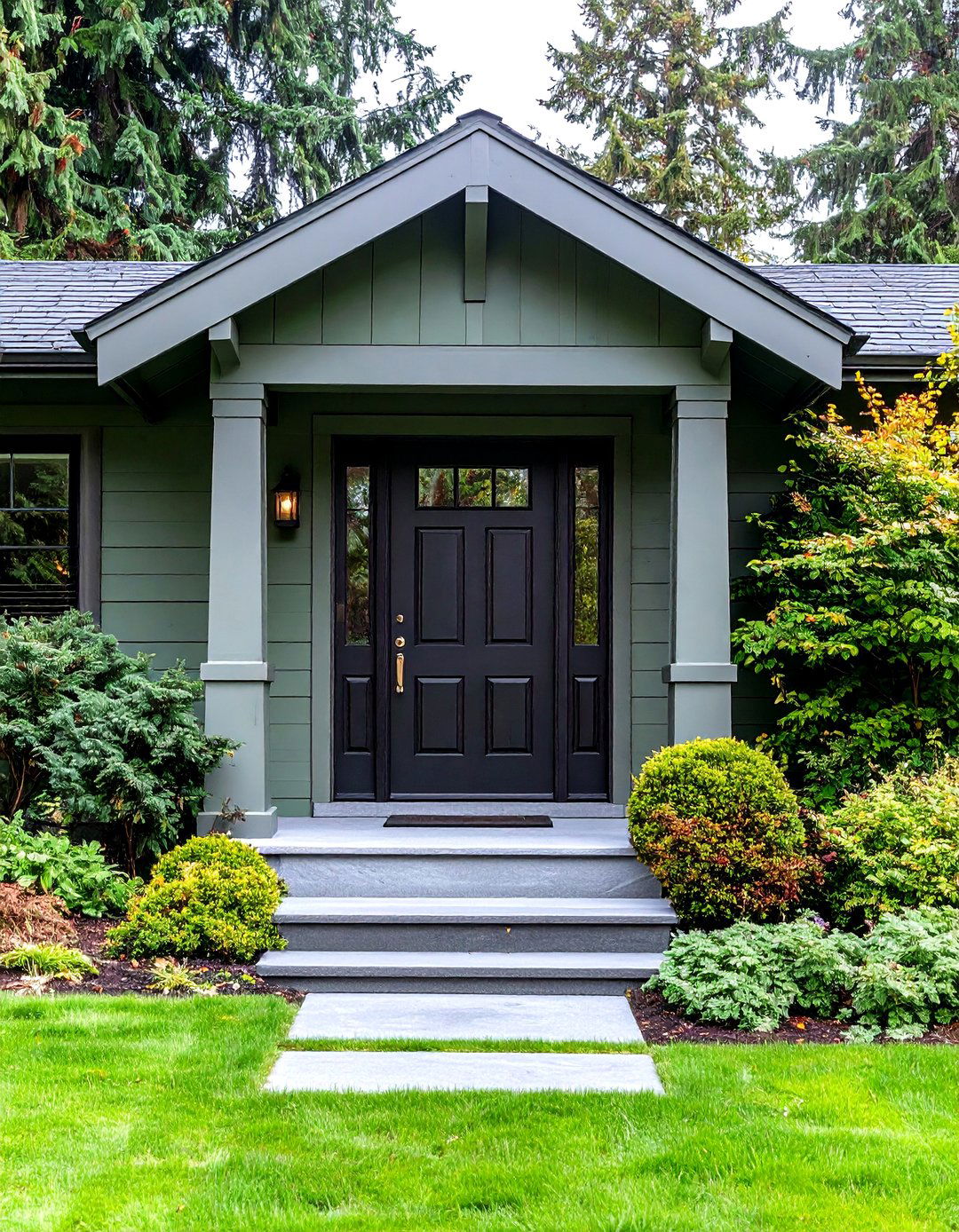
Sage green embodies both serenity and sophistication, blending calming green undertones with subtle gray notes to create a hue that promotes relaxation and balance. Designers often choose sage green for its ability to harmonize with natural surroundings, making it ideal for homes nestled among gardens or wooded landscapes. Its muted quality allows it to function almost like a neutral, pairing seamlessly with a range of accent colors and materials. When contrasted with a bold black door, the sage backdrop feels even more tranquil, as the deep, grounding black enhances the green’s soothing presence.
2. Choosing the Right Sage Shade
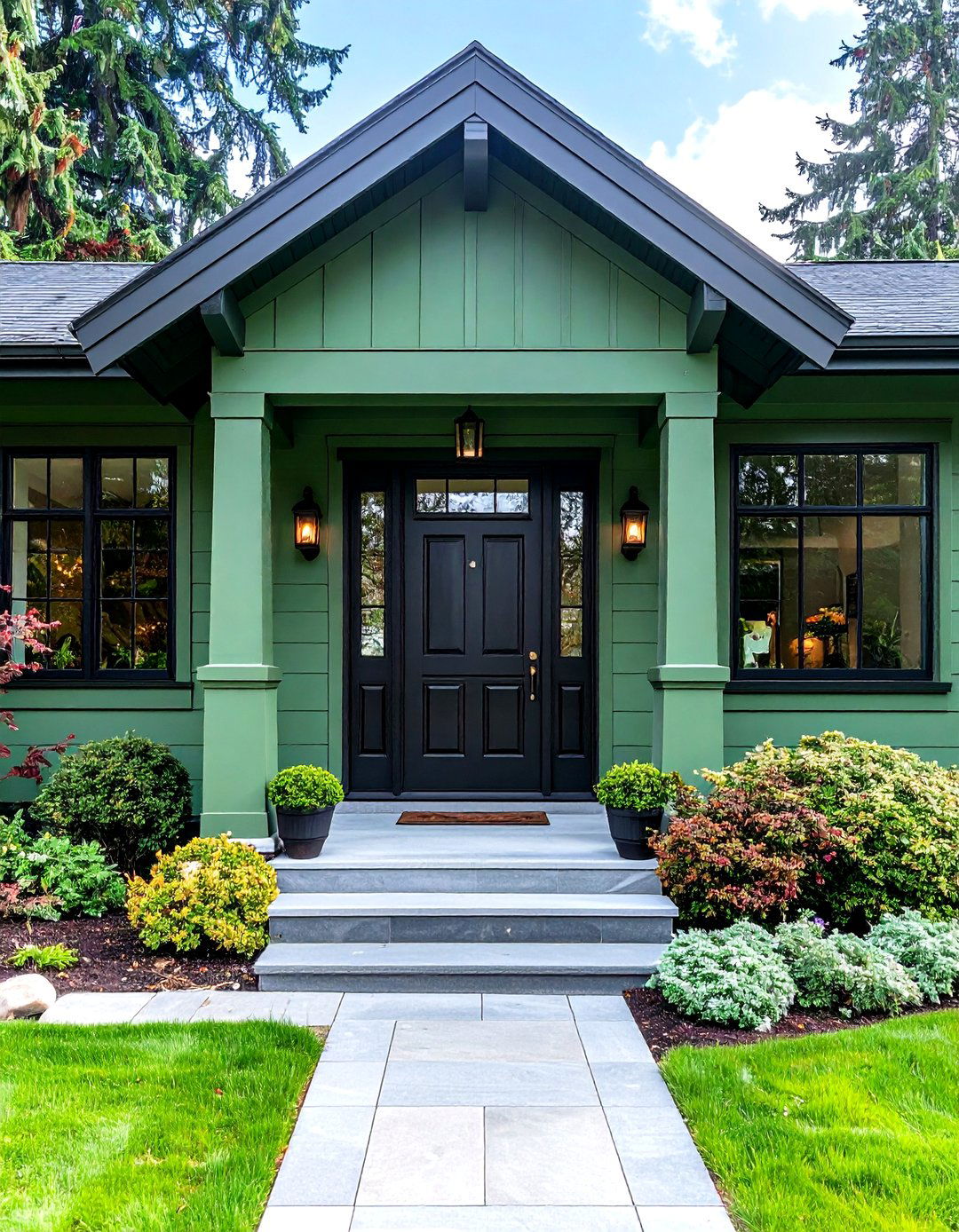
Not all sage greens are created equal—some lean more gray, while others echo warmer olive tones. Mid-tone sage hues like Benjamin Moore’s Saybrook Sage offer versatile neutrality that suits both classic and contemporary homes, adapting well to different light exposures and architectural details. When selecting paint, sample multiple shades on various walls and observe them at different times of day; natural light can dramatically shift a paint’s appearance. Aim for a tone that complements your home’s existing materials—brick, stone, or wood—and sets the stage for the crisp contrast of a black door.
3. The Impact of a Black Door
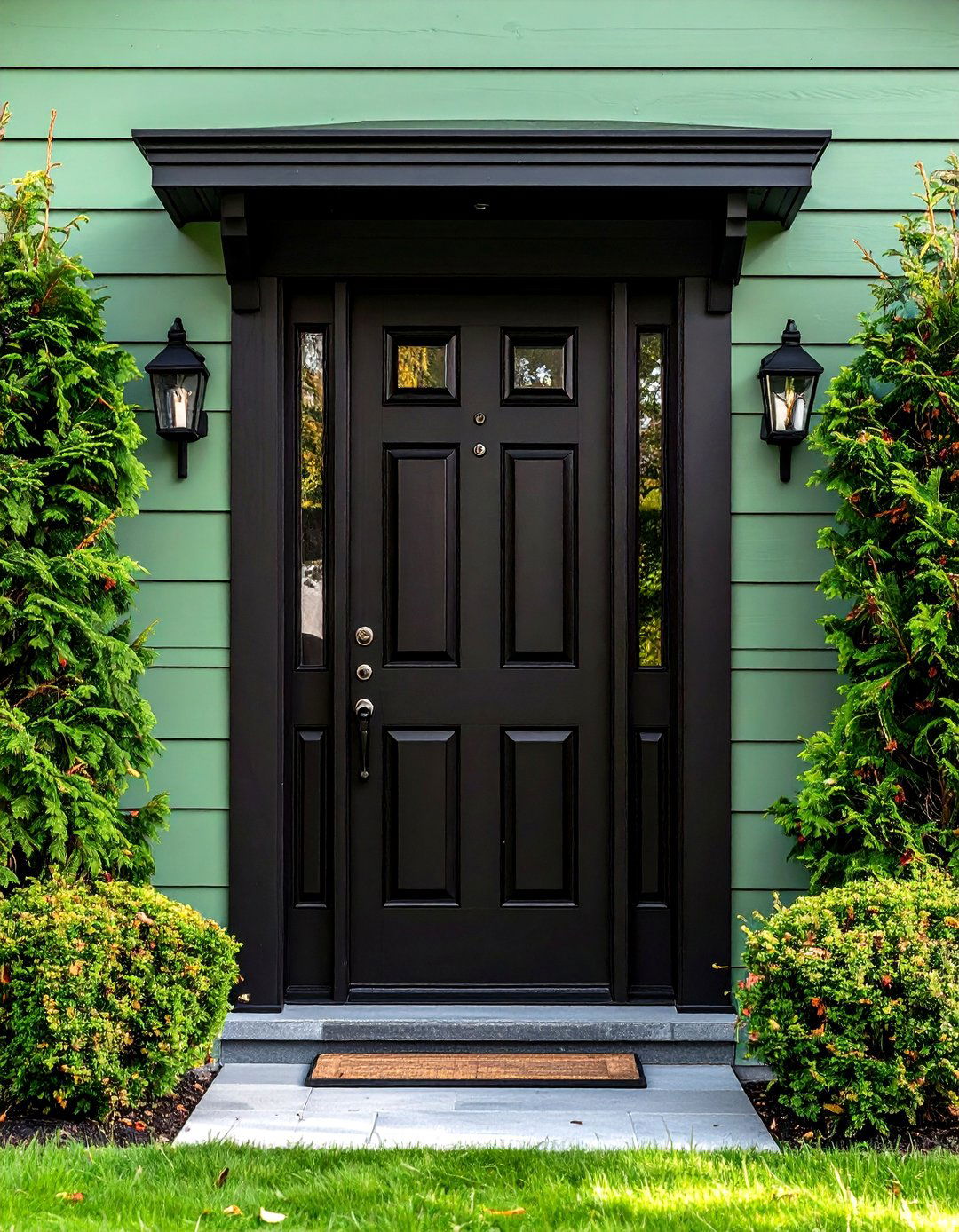
A black front door adds instant drama and focus, acting as an anchor against the soft sage façade. Rich charcoal or pure black creates a striking focal point, drawing the eye and framing the entrance dramatically. Black’s timeless elegance complements both traditional and minimalist designs, while its depth can conceal wear on wooden or metal doors. To maximize impact, choose a finish—matte, satin, or gloss—that aligns with your home’s style: matte for modern minimalism, satin for transitional looks, and gloss for classic, high-shine appeal.
4. Architectural Styles: From Colonial to Contemporary
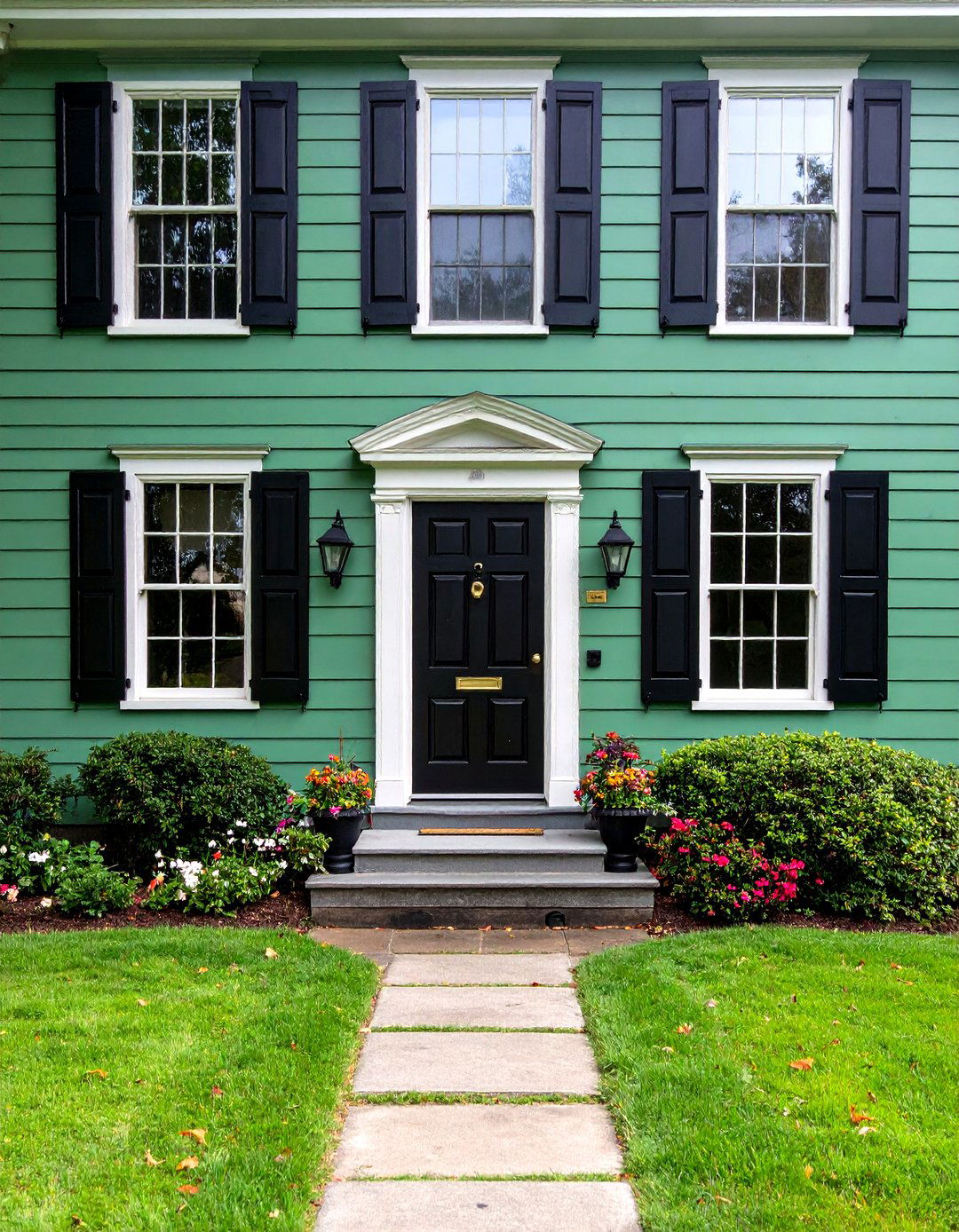
Sage green and black pair beautifully across architectural genres. Colonial-style homes benefit from black shutters and a centered black door that highlight symmetry and formal layouts, as seen in examples of colonial sage houses with black accents. Meanwhile, contemporary designs leverage the palette’s modern edge—think sleek lines, large glazed panels, and black-framed windows that mirror the door’s hue. The versatility of sage green allows it to feel fresh on a craftsman bungalow as well as clean on a minimalist cube, adapting seamlessly to different structural vocabularies.
5. Material Pairings: Cladding, Trim, and Accents
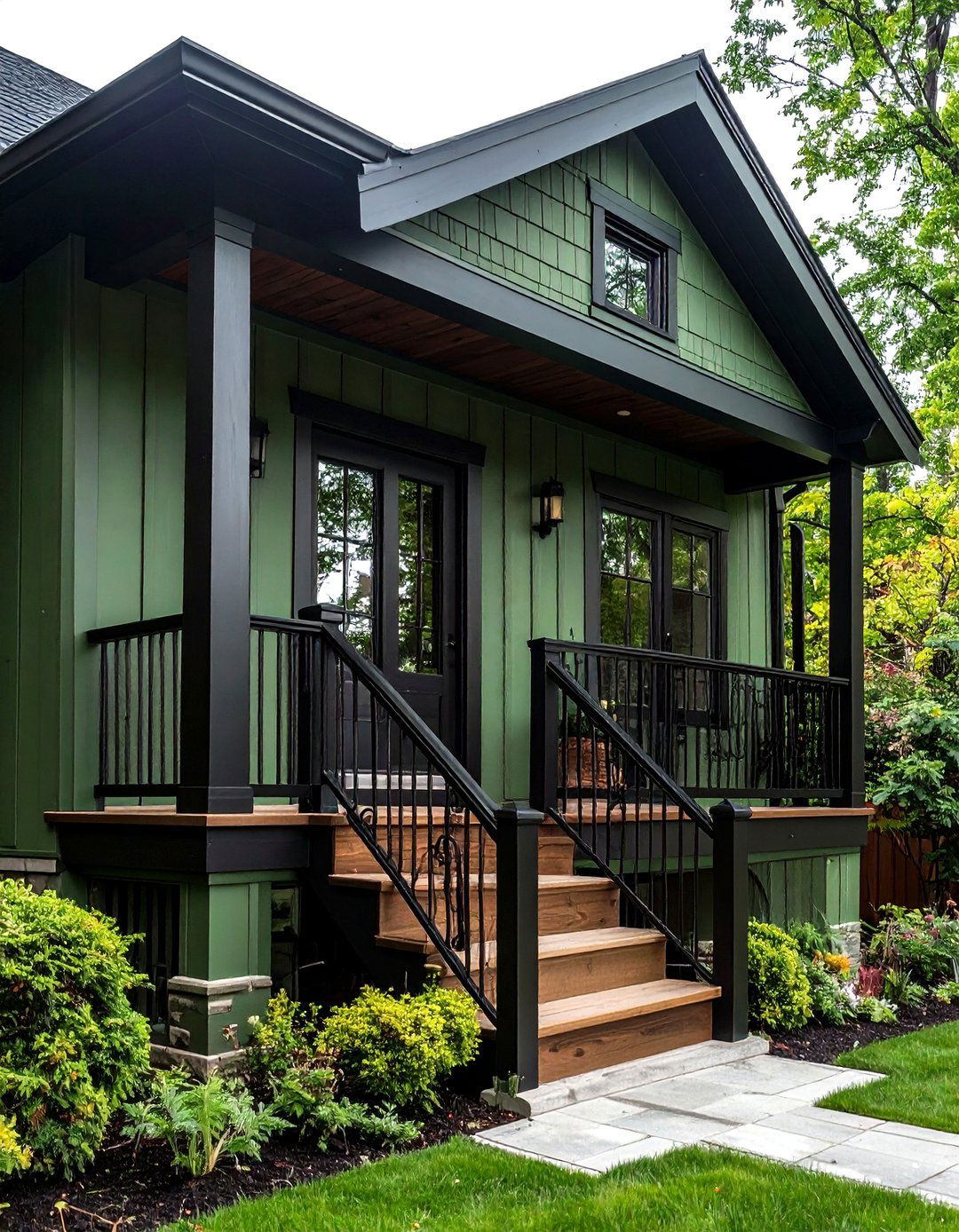
Combining sage green render or cladding with black trim creates depth and visual interest. Natural materials like timber or stone complement sage’s organic feel, while black metal railings or window frames introduce contrast and durability. Sustainable cladding options—fibre cement or treated softwood—offer longevity and low maintenance, enhancing both insulation and aesthetics. Consider extending cladding inside covered porches for cohesion, and use black accents sparingly on gutters, downspouts, and house numbers to tie the design together without overwhelming the soft green backdrop.
6. Garage Door and Additional Black Elements

Extending the black accent beyond the front door—including the garage door, fencing, and railings—reinforces a cohesive, intentional design. A matte-black garage door offers a sleek, modern counterpoint to sage siding, while black metal fencing and railings frame outdoor spaces with crisp definition. By choosing consistent finishes across all external hardware, you ensure a unified aesthetic. For metal surfaces, powder-coated black paint provides weather resistance and hides fingerprints, whereas wood doors benefit from durable enamel finishes that protect against moisture and fading.
7. Lighting and Hardware Choices
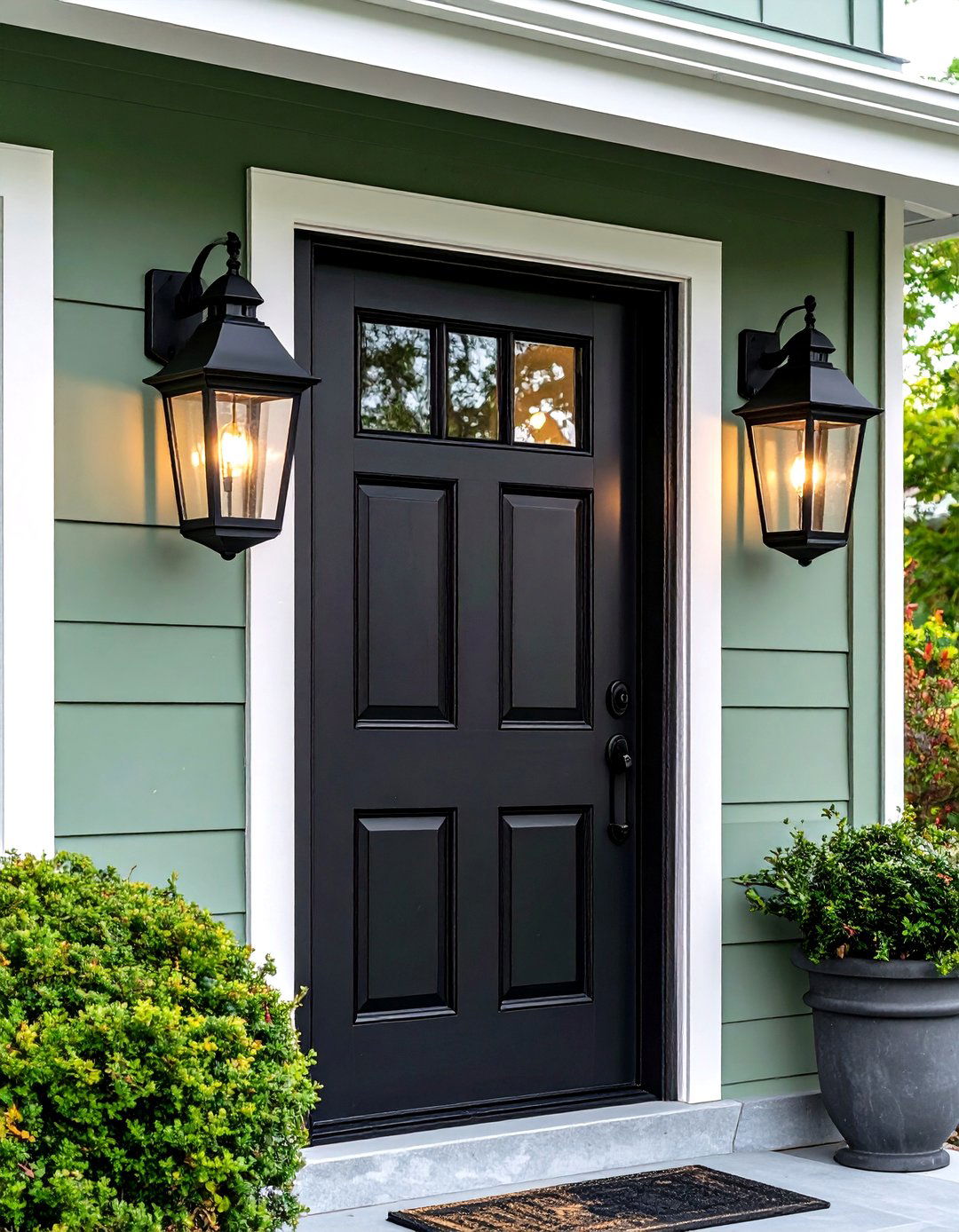
Lighting fixtures and hardware are small details that greatly influence the overall look. Black-finished lanterns, sconces, and door knockers echo the door color, reinforcing contrast and guiding the eye to the entrance. Opt for simple, geometric shapes for a modern feel, or classic lantern silhouettes for traditional charm. Matte-black house numbers and mailboxes further integrate the accent color. Ensure fixture scale matches your home’s proportions—oversized lights can overpower a modest porch, while undersized hardware may look lost on a grand façade.
8. Seasonal Curb Appeal
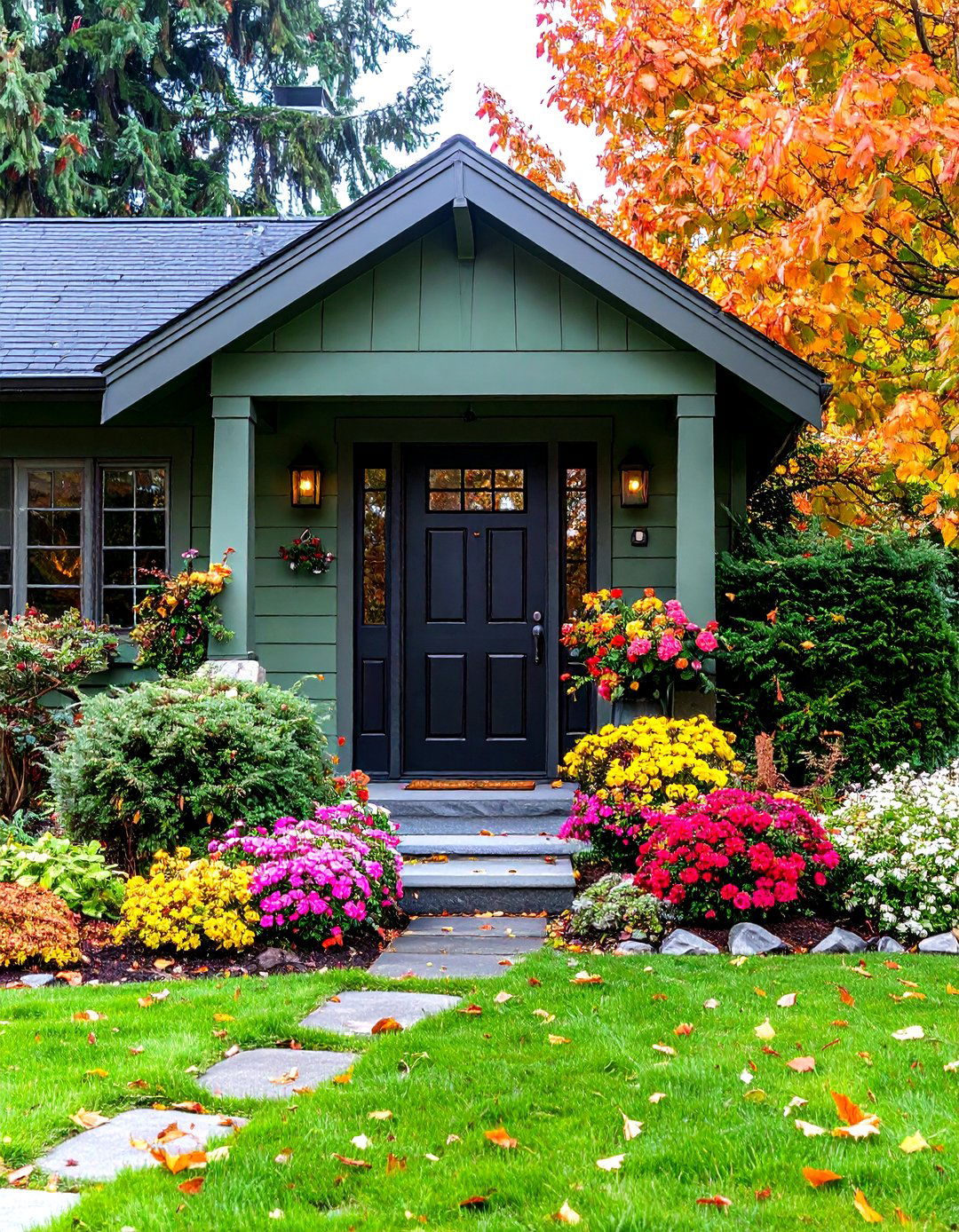
Sage green exteriors shine year-round: soft and verdant in summer, muted against autumn leaves, and subtly sophisticated against winter’s whites. Plantings with seasonal blooms—lavender, white hydrangeas, or deep-blue salvia—complement sage’s earthy tones, while evergreen shrubs maintain structure in colder months. For holiday décor, black door wreaths or bows tie into the palette seamlessly. Consider seasonal door mats or planters in warm metallics like copper or brass to inject subtle warmth and contrast without clashing with the core color scheme.
9. Landscape Integration
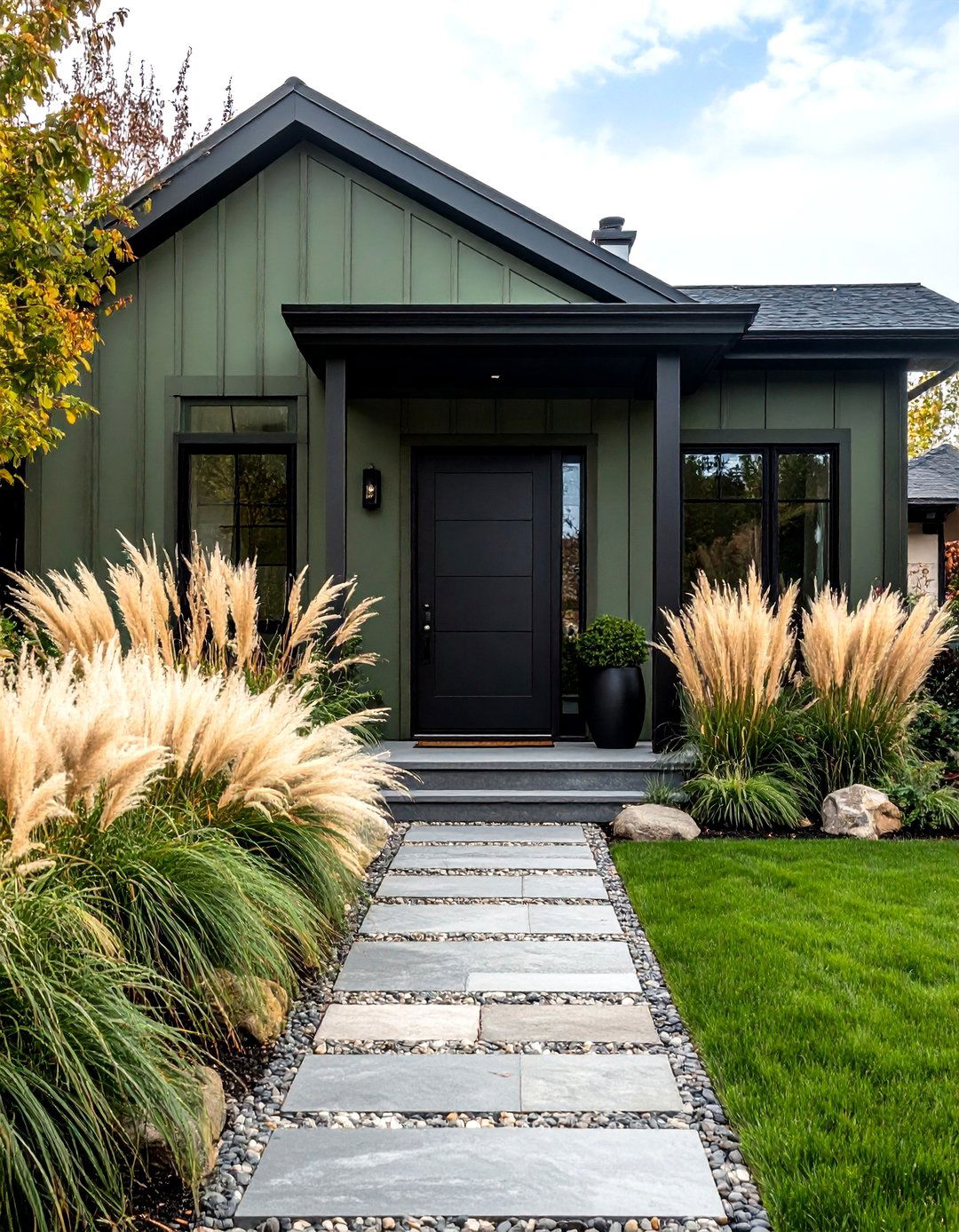
Integrating landscaping into your sage-and-black exterior underscores the palette’s organic roots. Soft green foliage, ornamental grasses, and stone pathways echo the house color, while black metal planters or wood trellises mirror the door accent. Groundcovers like creeping thyme or clover soften hardscapes and harmonize with sage siding. Strategically placed uplights can highlight specimen trees or architectural features at night, with fixtures painted black to remain discreet. A cohesive landscape design ensures the home feels grounded in its environment, creating an inviting, unified streetscape.
10. Interior-Exterior Color Flow
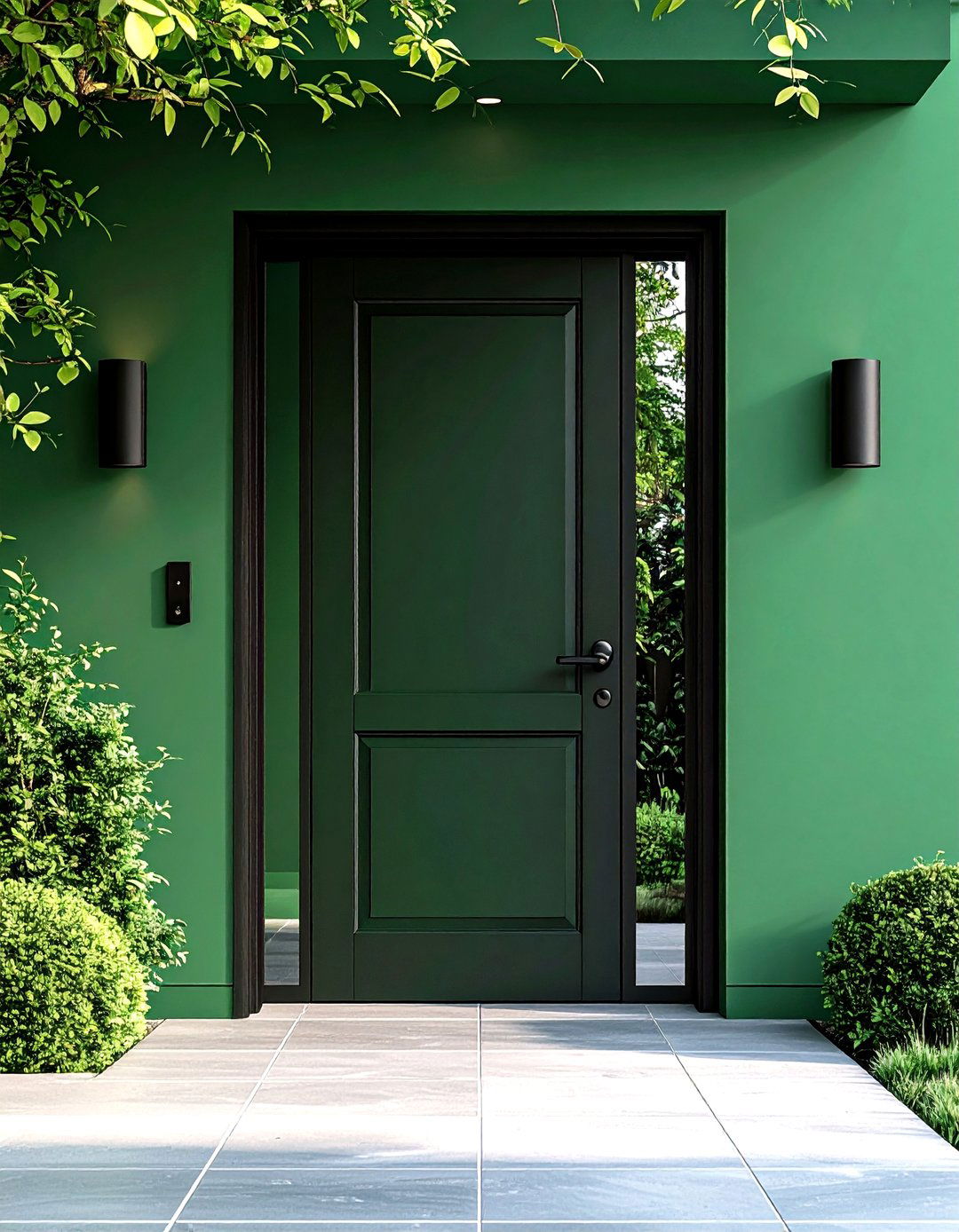
Linking interior and exterior palettes enhances design continuity. If sage green appears on the exterior, consider echoing it on an interior feature wall, kitchen cabinetry, or bathroom vanity. Complementary materials—natural wood countertops or linen textiles—reinforce the theme. Black door hardware inside the home, such as cabinet pulls or light fixtures, references the exterior door color, creating a subtle thread throughout. This holistic approach fosters a seamless indoor-outdoor transition, especially in open-plan homes with visible entryways.
11. Paint Brand Comparisons
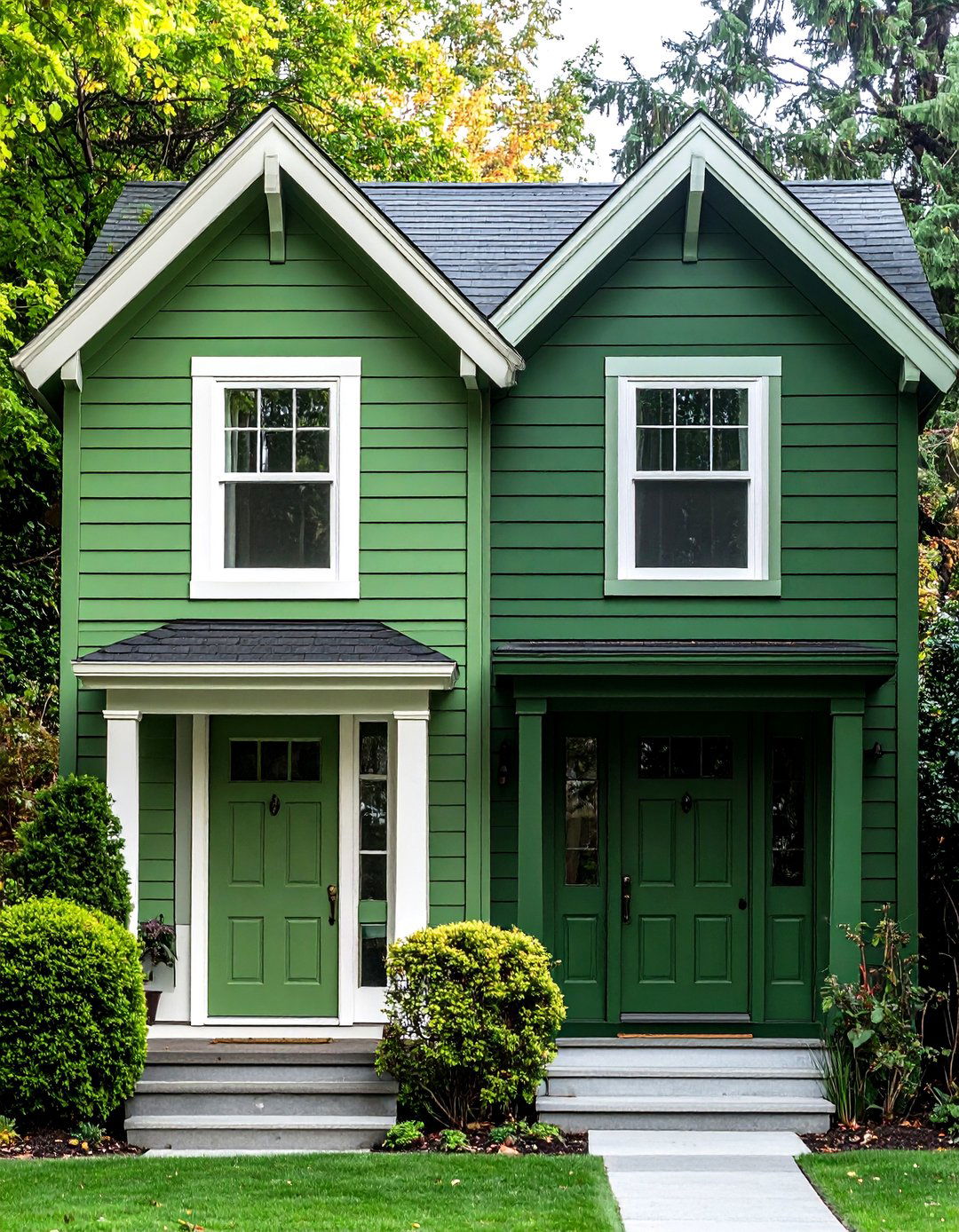
Leading paint brands offer sage greens tailored to exterior durability. Benjamin Moore’s Saybrook Sage is prized for its color consistency and weather-resistant formulation, while Sherwin-Williams’ Evergreen Fog provides a slightly warmer undertone. Always choose exterior-grade paints with mildewcides and UV protection. Sampling is crucial: apply large swatches on different walls and inspect them under morning, midday, and evening light. Consult manufacturer data sheets for VOC content and warranty information, ensuring your investment withstands sun, rain, and temperature fluctuations over time.
12. Budget-Friendly Strategies
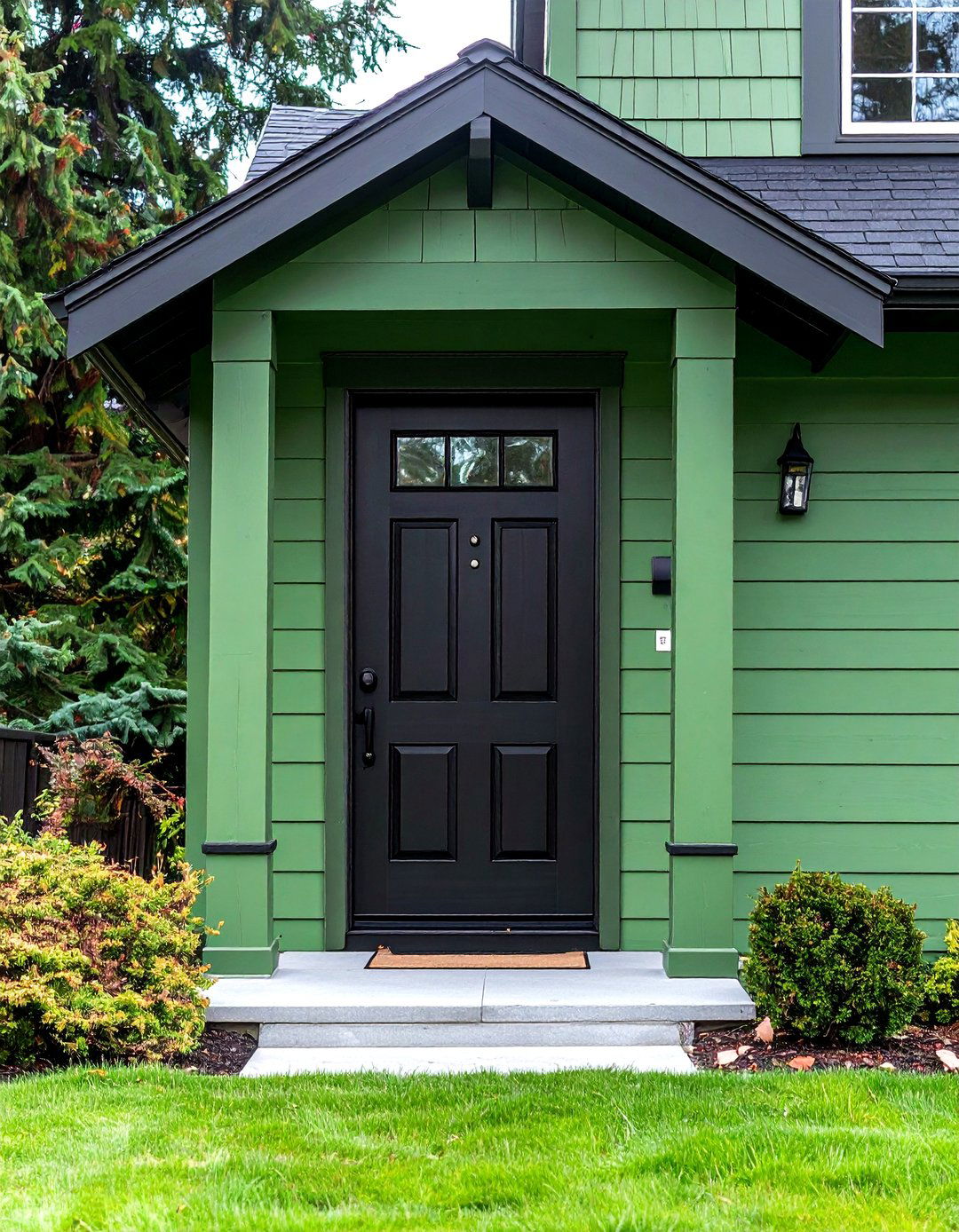
Achieving a high-end look need not break the bank. Focus spending on quality paint for high-exposure areas—siding and doors—while making cost-effective choices elsewhere, like vinyl trim or composite fascia. Pre-painted cladding panels can reduce labor costs compared to on-site spraying. DIY painting of doors and trim is feasible with proper preparation—sanding, priming, and using painter’s tape for crisp lines. For hardware, simple black powder-coated options offer affordability without sacrificing style. Prioritize maintenance investments, such as sealing and caulking, to prolong paint life and avoid costly repainting sooner.
13. Maintenance and Longevity
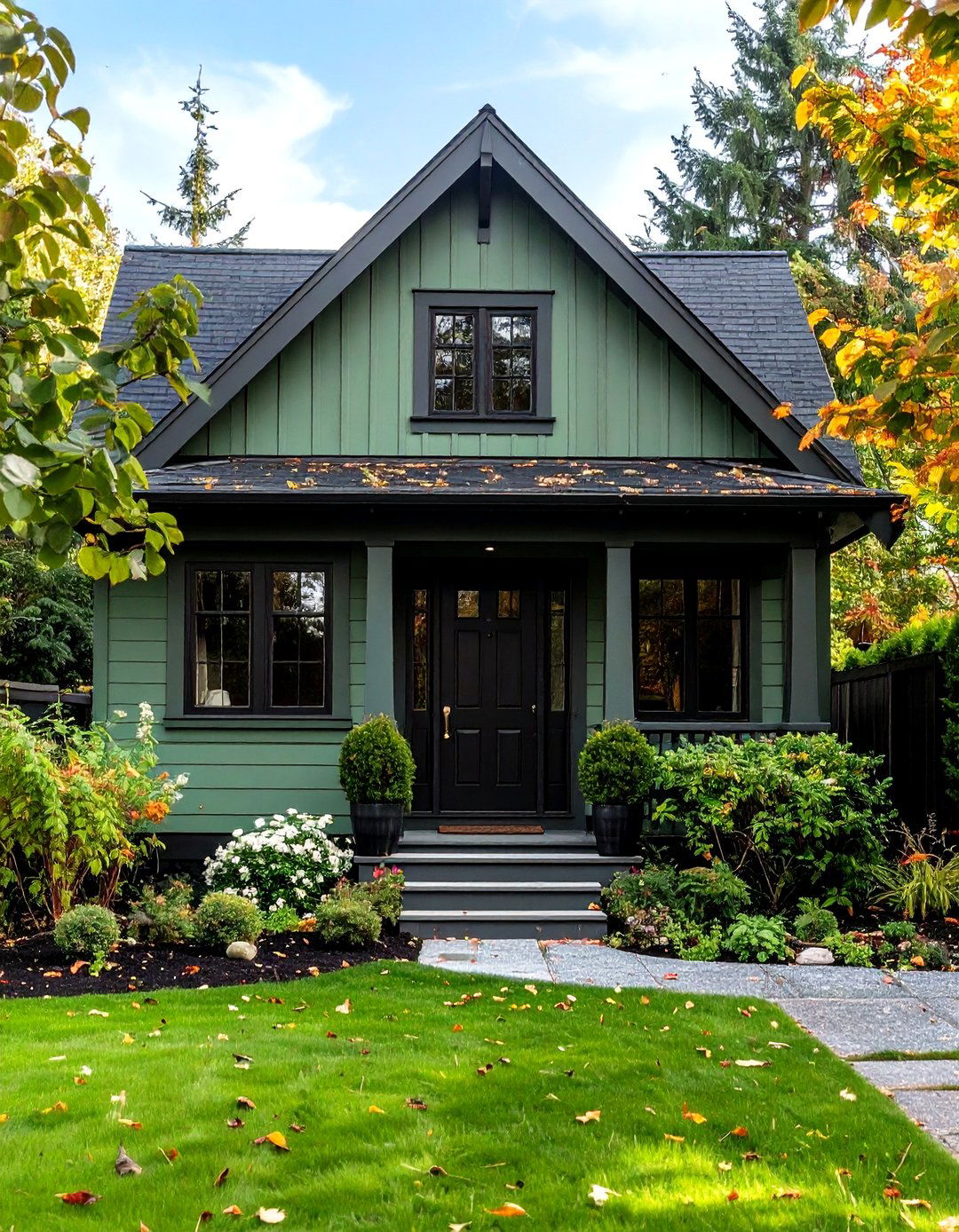
Regular maintenance preserves your sage-and-black exterior’s fresh appearance. Inspect cladding and painted surfaces annually for peeling or cracking, addressing issues promptly with caulk or touch-up paint. Clean surfaces with mild detergent and soft brushes to remove dirt and mildew. Black finishes may show dust or water marks more readily; a quick rinse keeps them crisp. For metal components, monitor for rust and apply rust-inhibiting primers as needed. Investing in high-quality exterior paints and sealants pays dividends in longevity and reduces lifecycle costs.
14. Regional and Climate Considerations
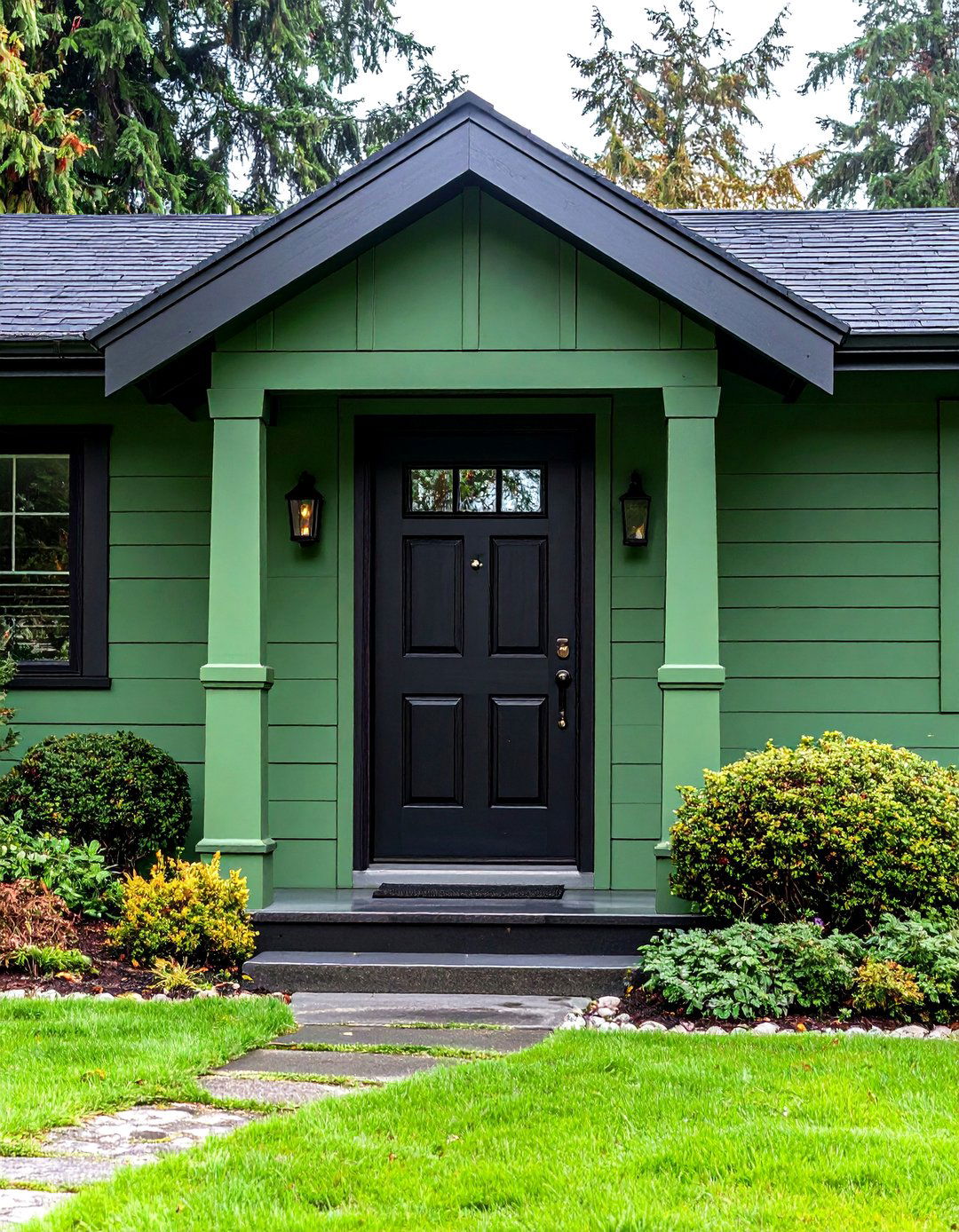
Climate influences paint performance and color perception. In humid regions, select paints with mold resistance; in sunny climates, prioritize UV-stable pigments to prevent fading. Sage green may appear cooler in shaded northern façades and warmer under intense southern sun—adjust tonality accordingly. Black doors can absorb heat; in scorching areas, consider heat-reflective coatings or lighter shades of charcoal to mitigate warping. Consult local painting professionals familiar with regional weather patterns to select products optimized for your environment.
15. Historic and Heritage Applications
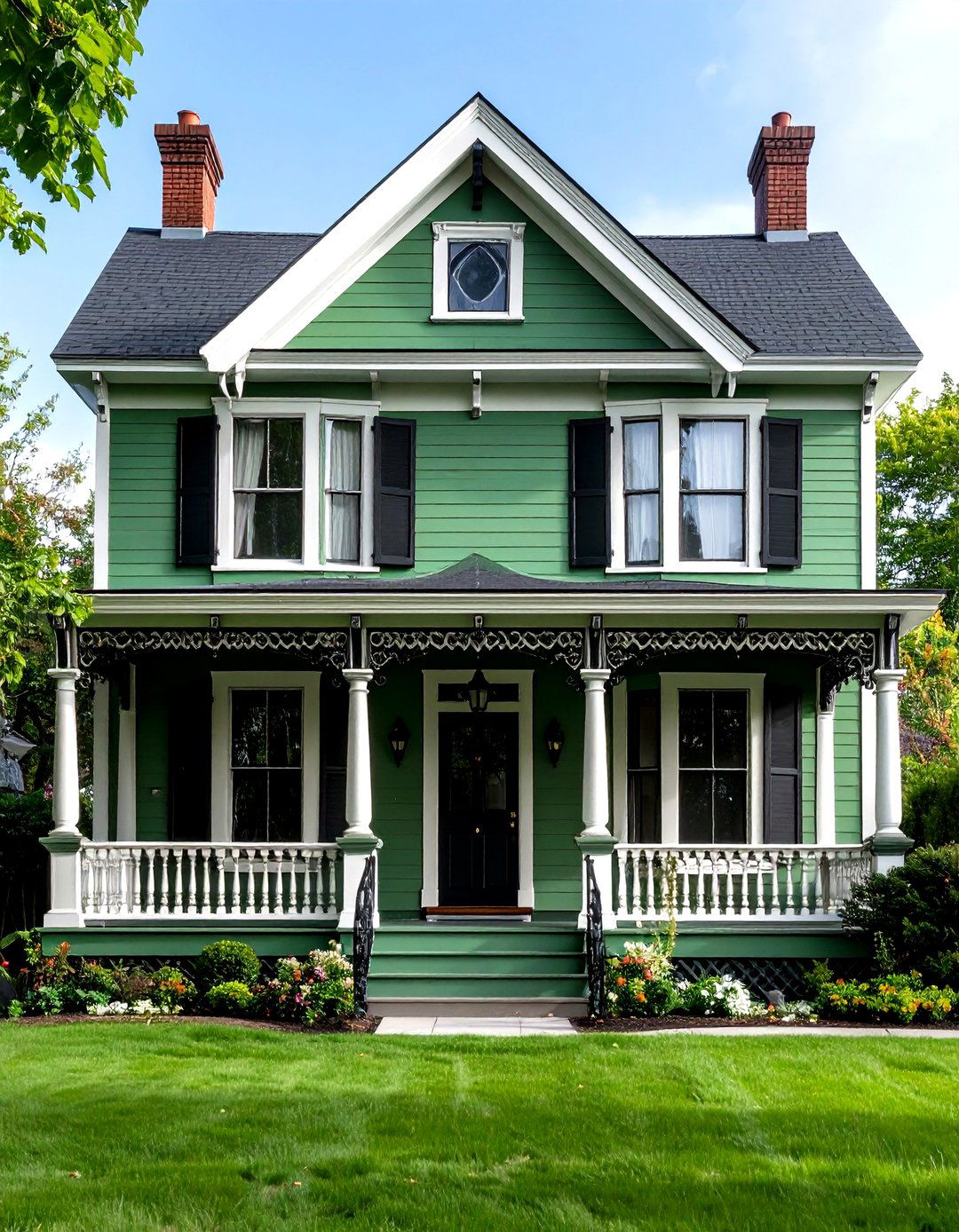
For period properties, sage green with black accents respects traditional palettes while introducing modern flair. Victorian homes can showcase sage walls with ornate black ironwork and turned-wood trim, whereas mid-century modern residences benefit from minimalist black-framed windows and sleek doors. Always check heritage guidelines before altering historic façades; choose paint formulations that match original textures—limewash for older masonry or chalky emulsion for timber weatherboards. This careful approach honors a building’s character and may qualify for preservation grants.
16. Contemporary Minimalism
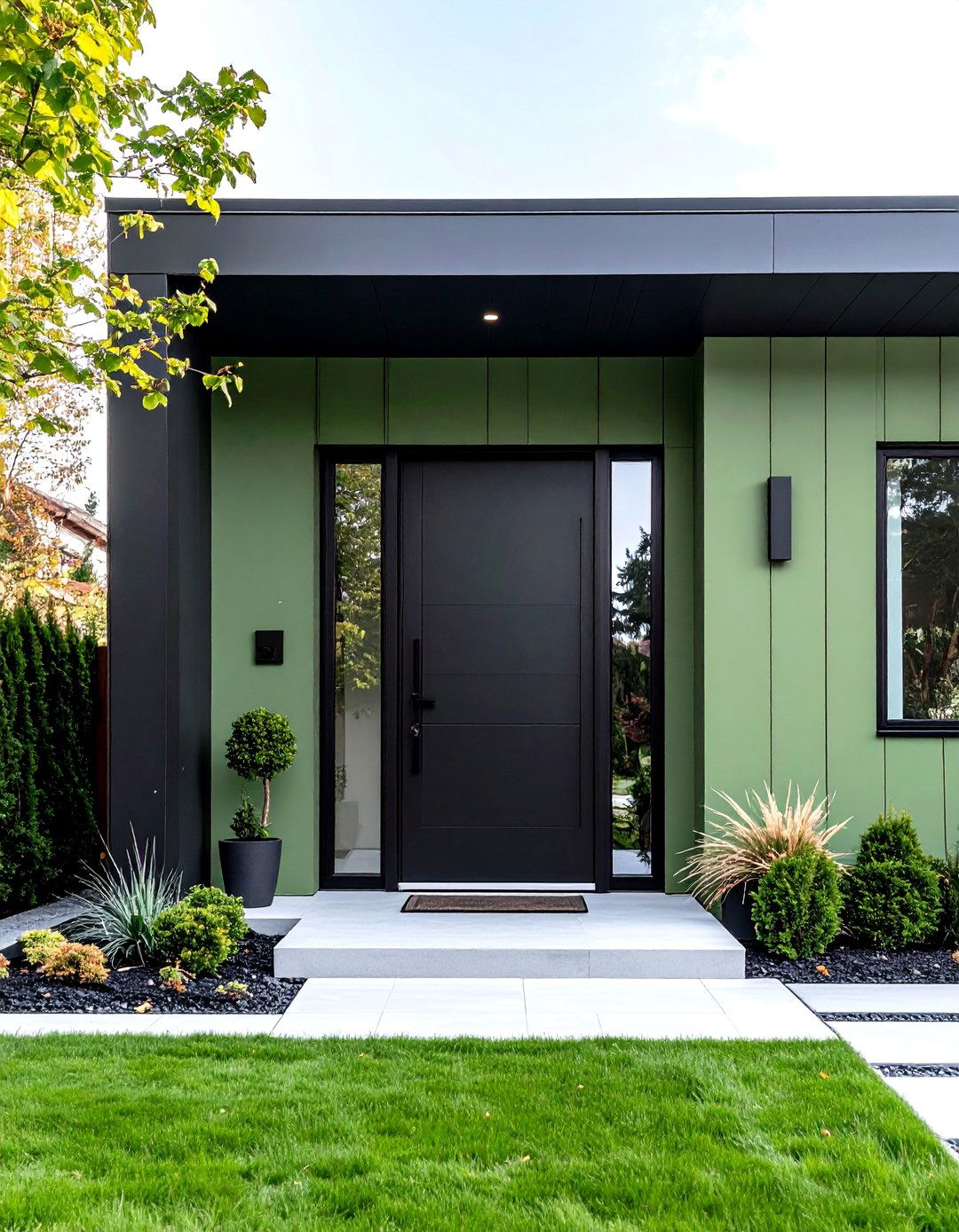
Minimalist designs emphasize clean lines and uncluttered façades. A smooth sage-green render paired with a flush, handleless black door exemplifies this ethos. Concealed gutters, integrated lighting strips, and frameless glazing maintain visual purity. Black steel beams or support columns echo the door’s geometry, creating a cohesive structural language. Landscaping follows suit: simple gravel beds, sculptural planters, and clipped hedges reinforce minimalist principles, allowing the sage-and-black palette to stand out without competing elements.
17. Cottage and Farmhouse Charm
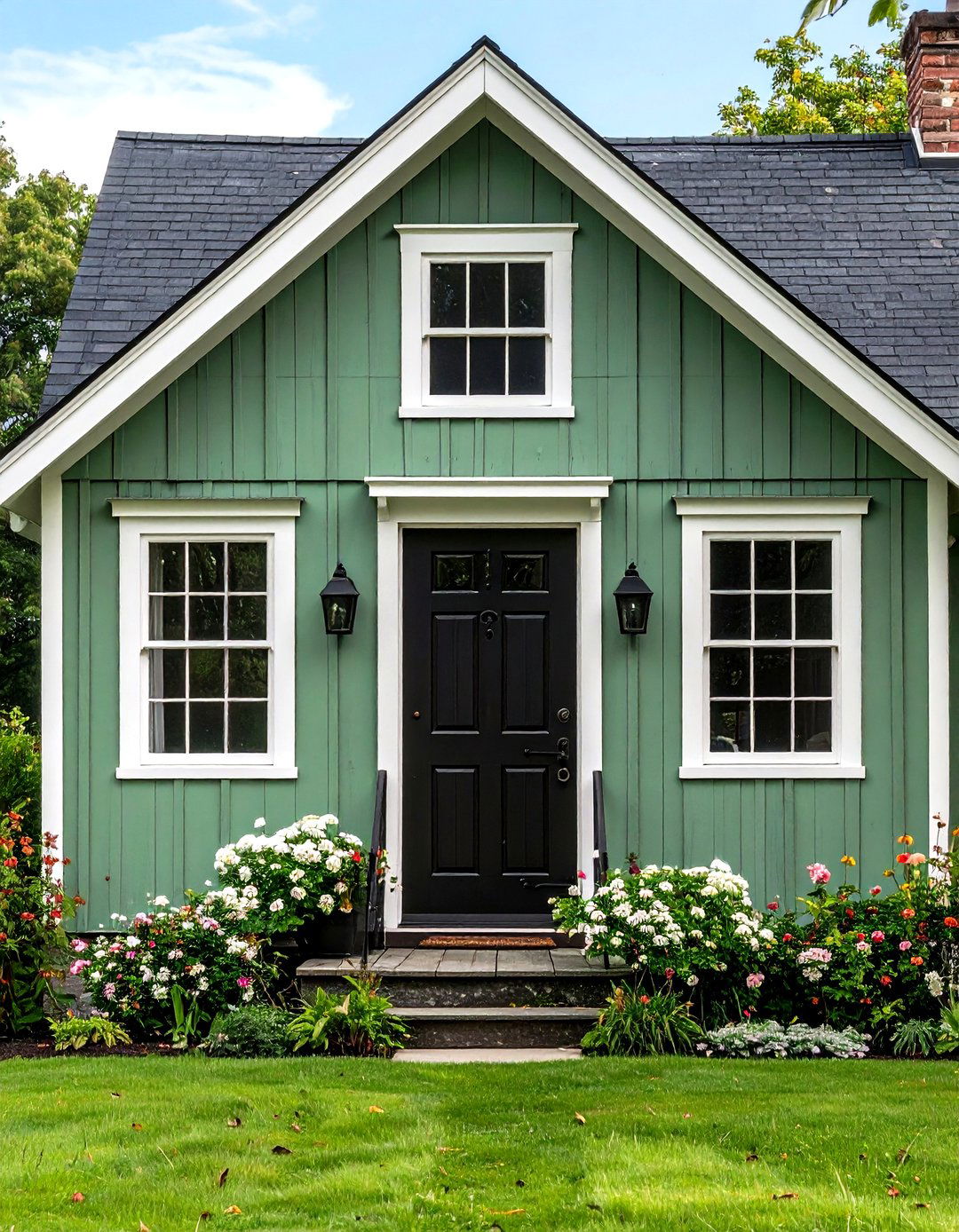
Sage green and black complement rustic cottage and farmhouse styles. Board-and-batten siding painted in a soft sage invokes pastoral tranquility, while a black door with wrought-iron hardware adds quaint charm. Pair with white window trim and a pitched roof clad in black metal or slate for classic appeal. Accents like black lanterns and barn-style sliding doors enhance authenticity. Incorporate textured materials—natural stone steps, exposed timber beams, and brick chimneys—to enrich the farmhouse narrative and root the color palette in rural tradition.
18. Enhancing Curb Appeal for Selling
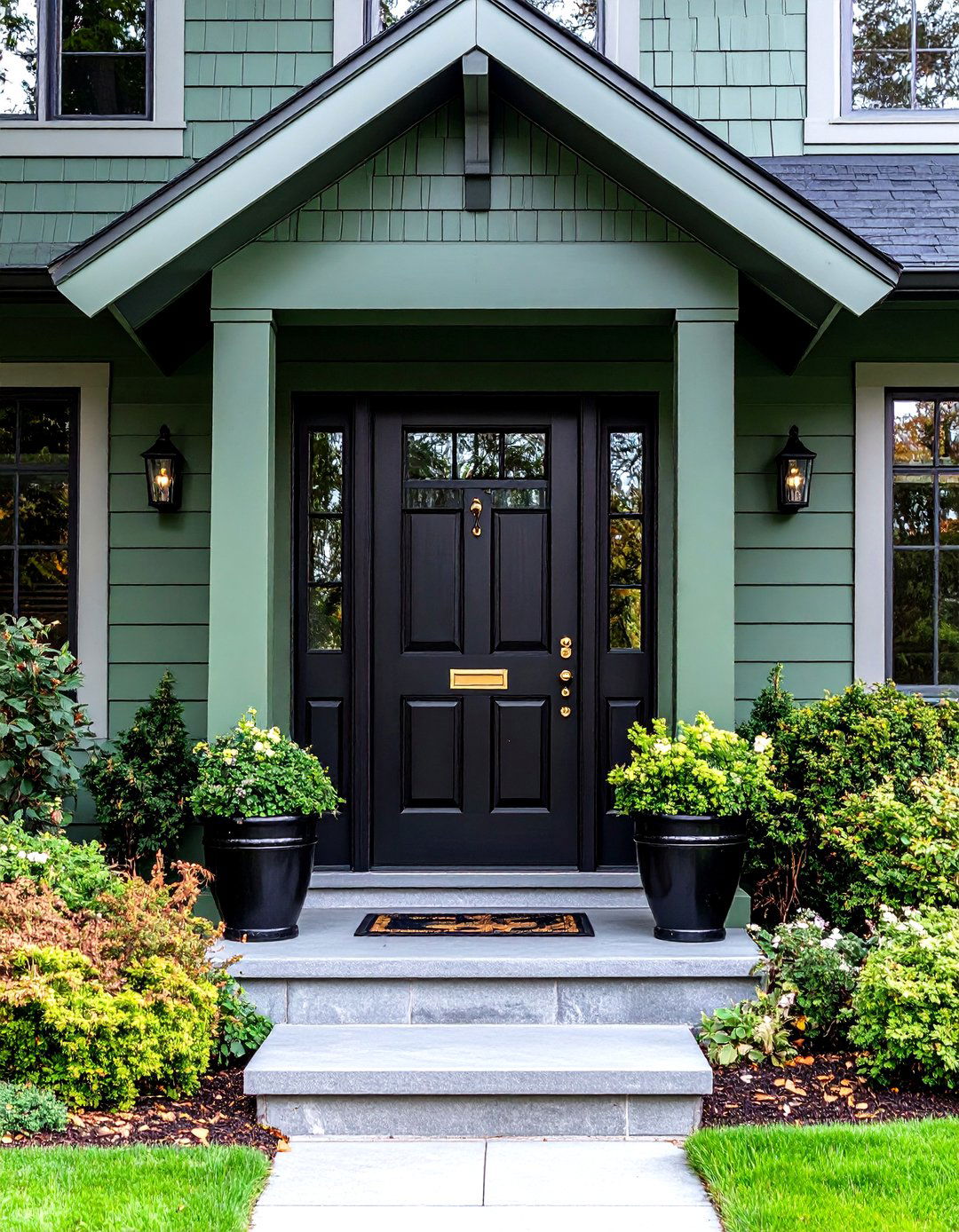
Homes with thoughtful exteriors command attention on the market. Sage green walls and a black door create a memorable façade that stands out in listing photos and drive-by viewings. Professional staging—potted greenery, coordinated outdoor rugs, and updated hardware—can elevate perception of value. Fresh paint signals upkeep, while a cohesive palette suggests design savvy. According to real estate experts, neutral yet distinctive color schemes help buyers envision themselves in the space, potentially shortening time on market and boosting offers.
19. DIY vs. Professional Painting
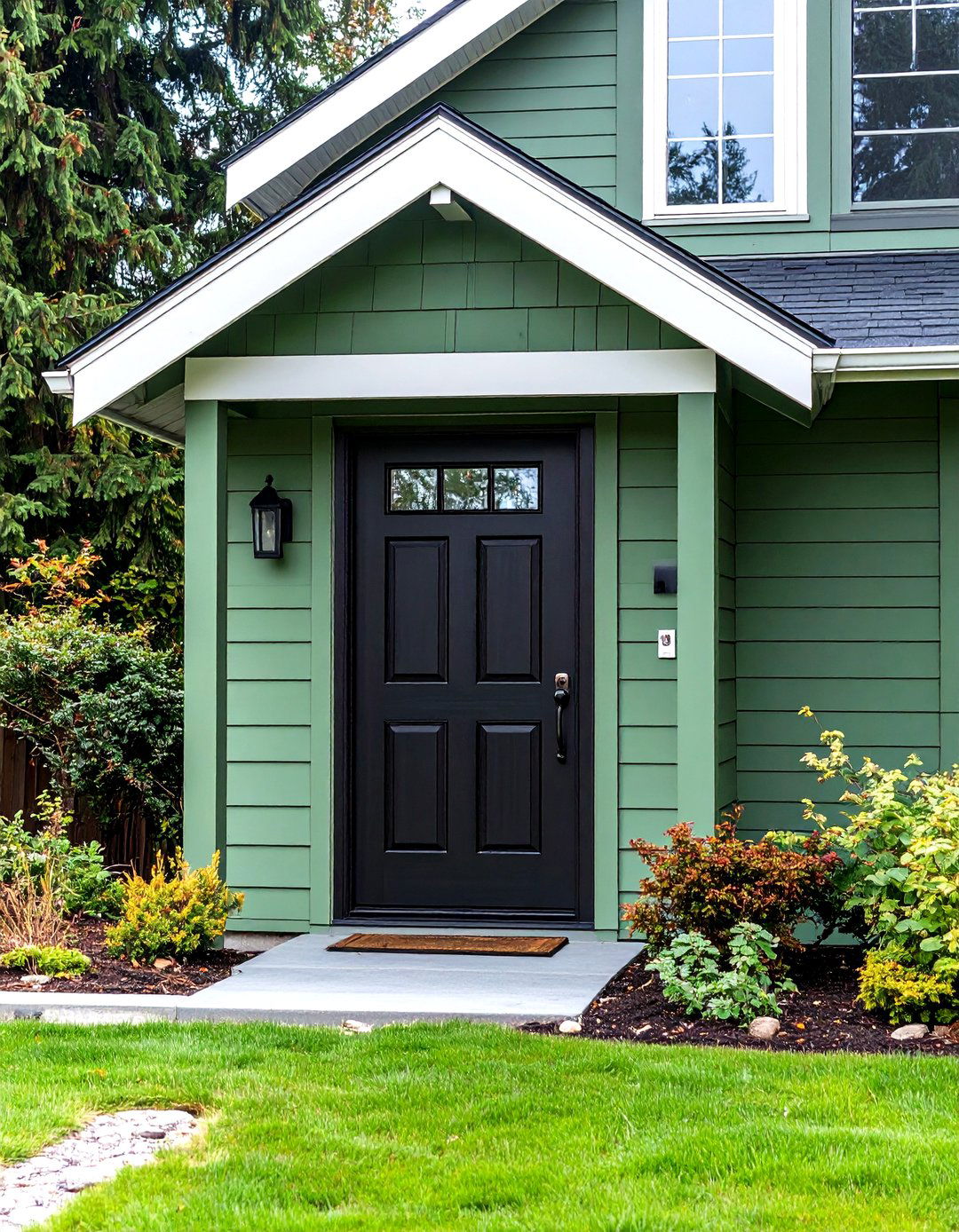
DIY painting offers cost savings but requires time and skill. Proper surface prep—power washing, scraping loose paint, sanding rough spots—is essential for lasting results. Use high-quality brushes and rollers suited to exterior textures. Taping off windows and trim ensures crisp lines, especially when switching between sage green and black. For large or complex façades, or when working at height, hiring professionals provides speed, safety, and warranty-backed workmanship. A professional crew can also handle specialized finishes, such as textured stucco or multi-tone applications, more efficiently.
20. Future Trends and Personalization
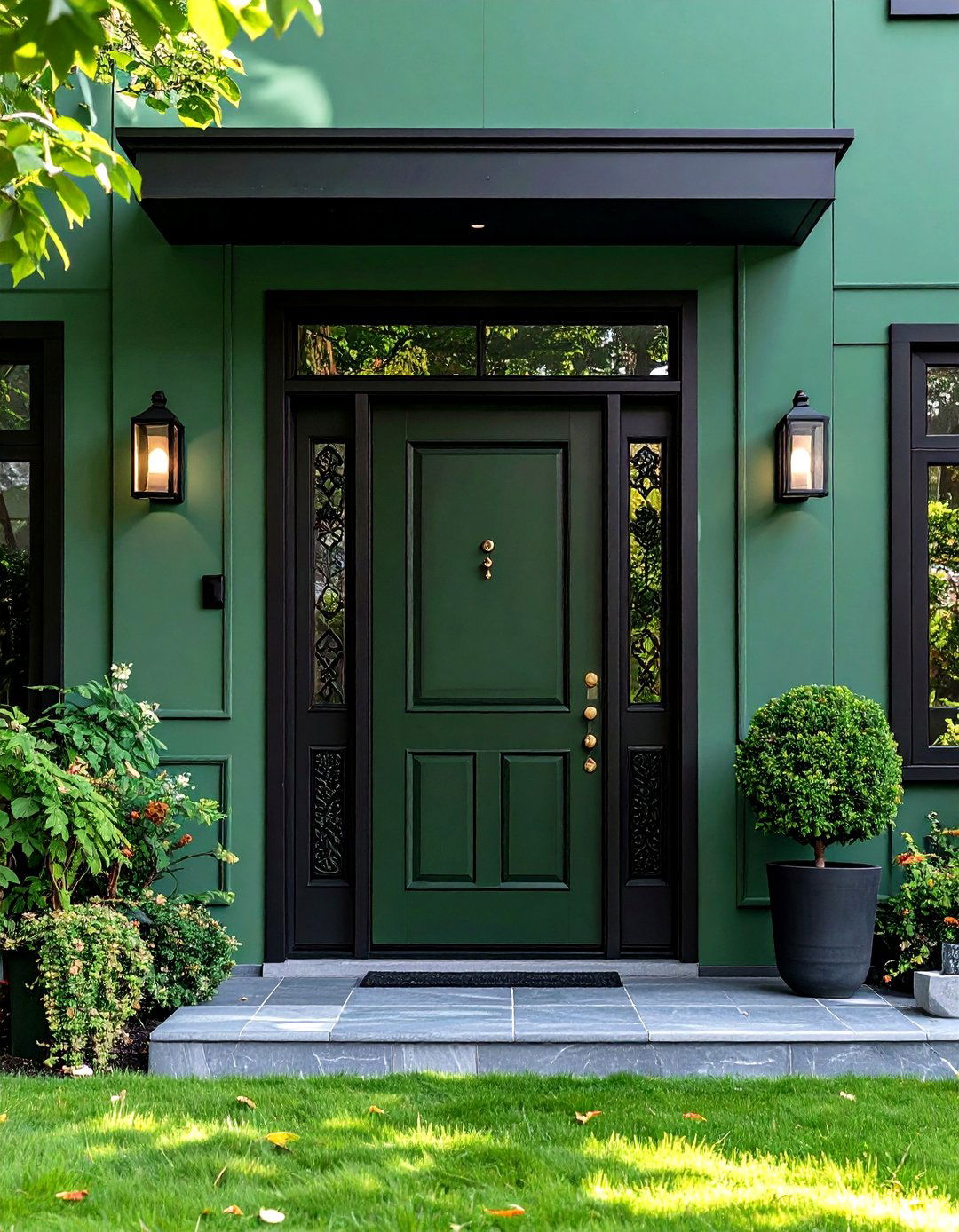
Looking ahead, sage green remains on trend, especially paired with black accents. Expect to see eco-friendly paint innovations—low-VOC, plant-based formulas—gain popularity, along with smart finishes that repel dirt or adjust reflectivity. Personal touches like custom door carvings, integrated lighting behind black steel house numbers, or art installations on sage walls will enhance uniqueness. As exterior living spaces evolve, seamless transitions—folding glass doors, covered patios with black beams, sage-green outdoor kitchens—will further blur lines between interior and exterior, making the sage-and-black palette more immersive than ever.
Conclusion:
By thoughtfully combining sage green exteriors with a bold black door, homeowners can achieve a harmonious blend of calm and contrast that works across architectural styles and climates. From paint selection and material pairings to lighting, landscaping, and maintenance strategies, each element contributes to a cohesive, enduring design. Whether you aim for historic charm, minimalist rigor, or modern farmhouse warmth, this versatile palette ensures your home stands out with timeless elegance and inviting appeal.


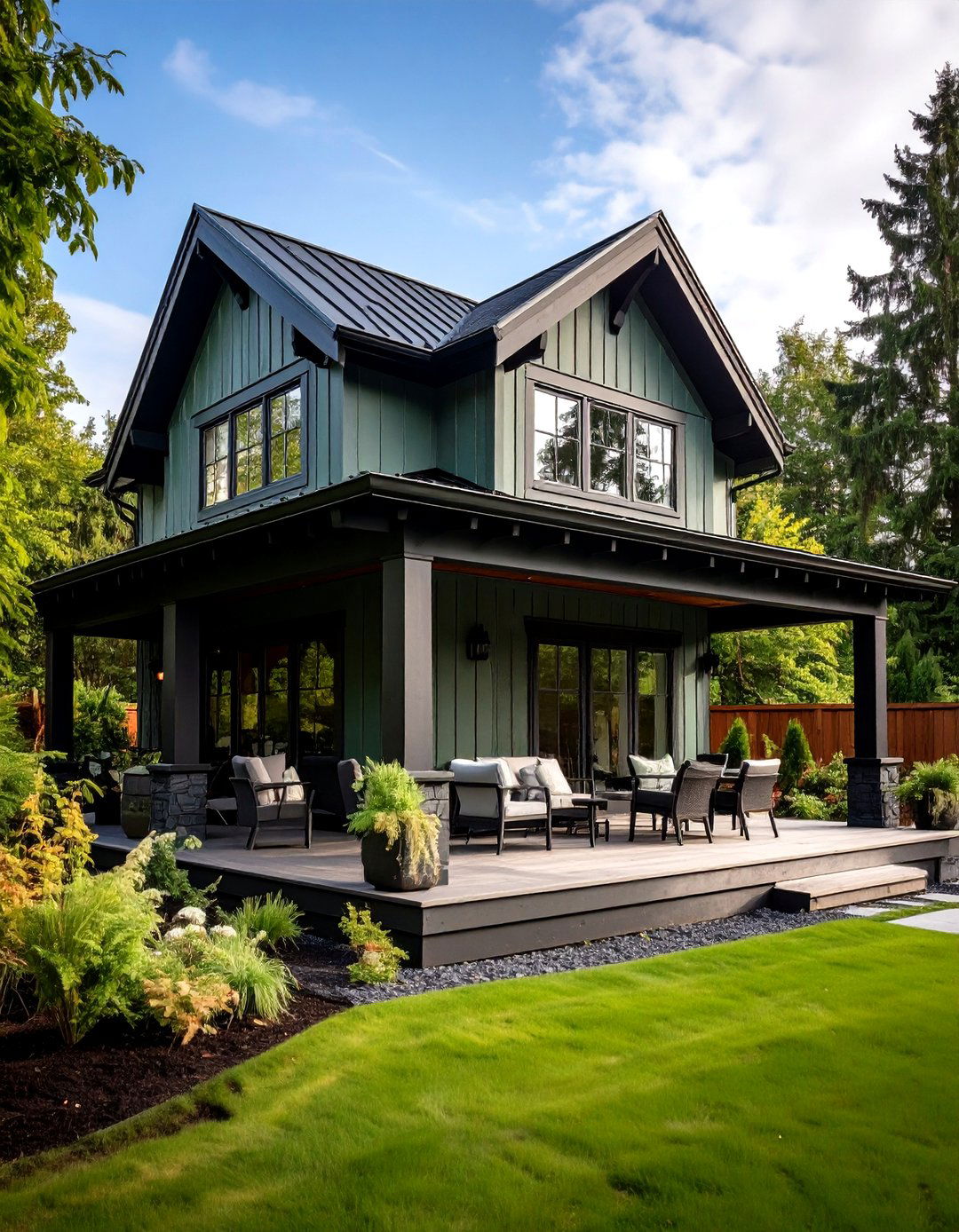
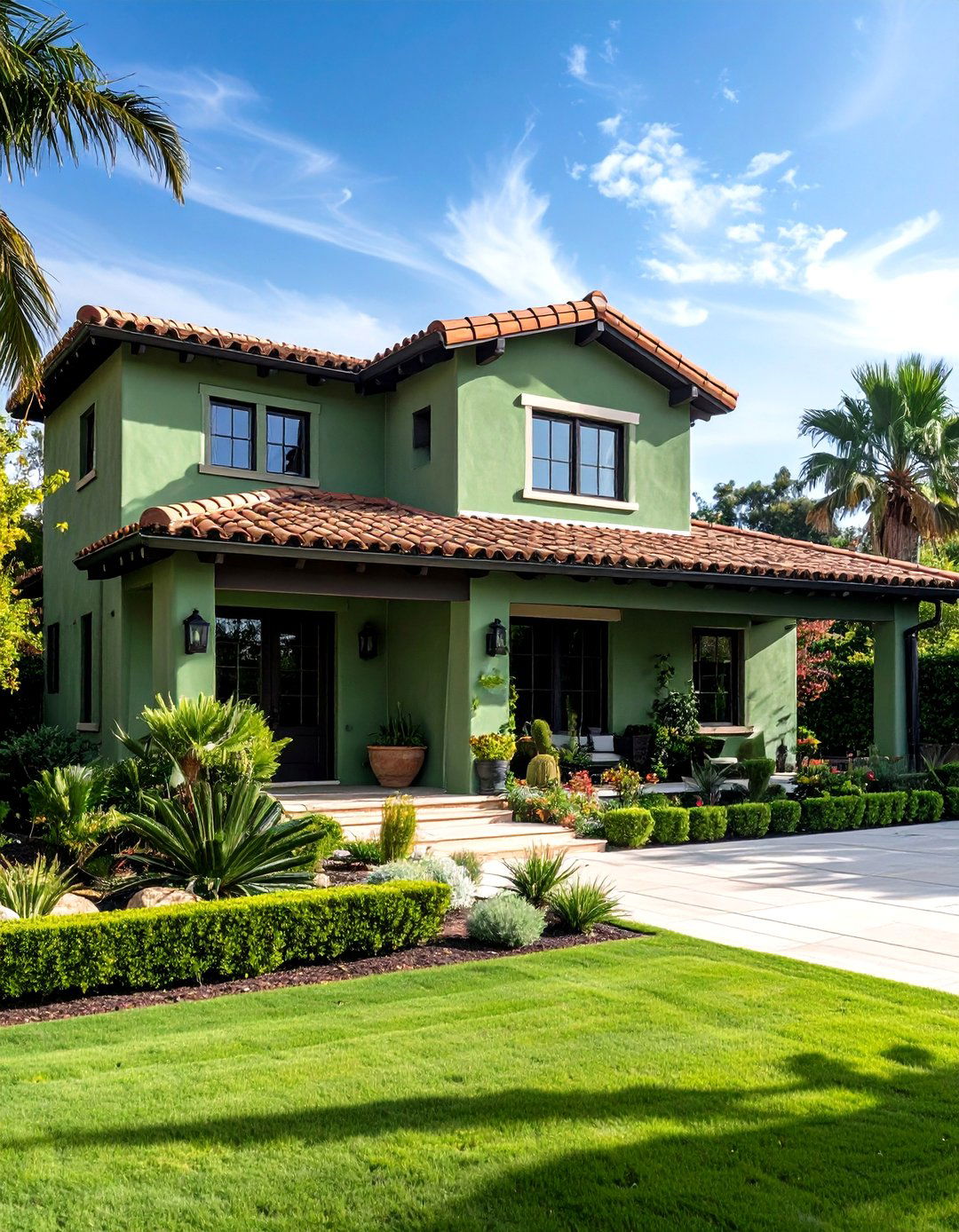
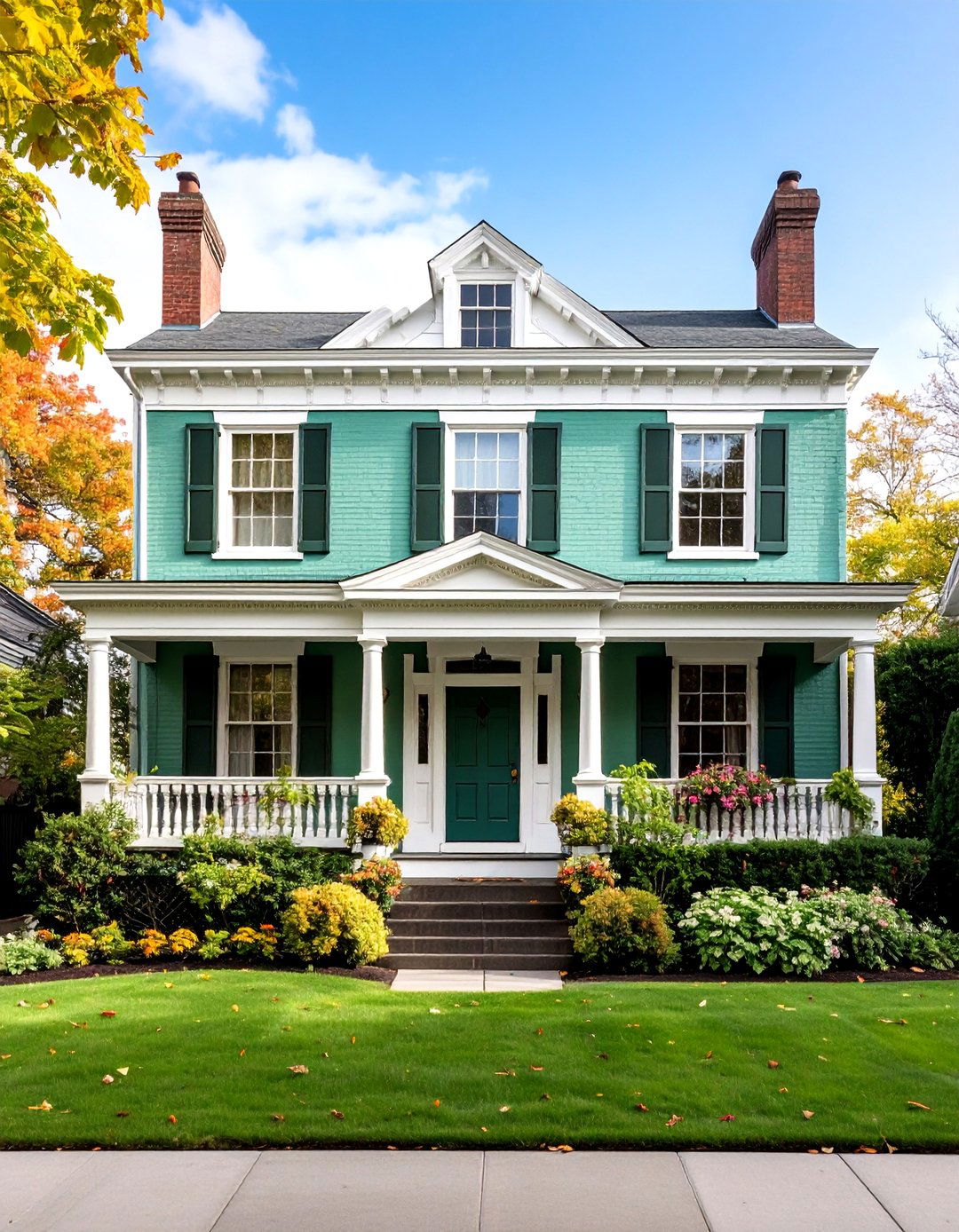
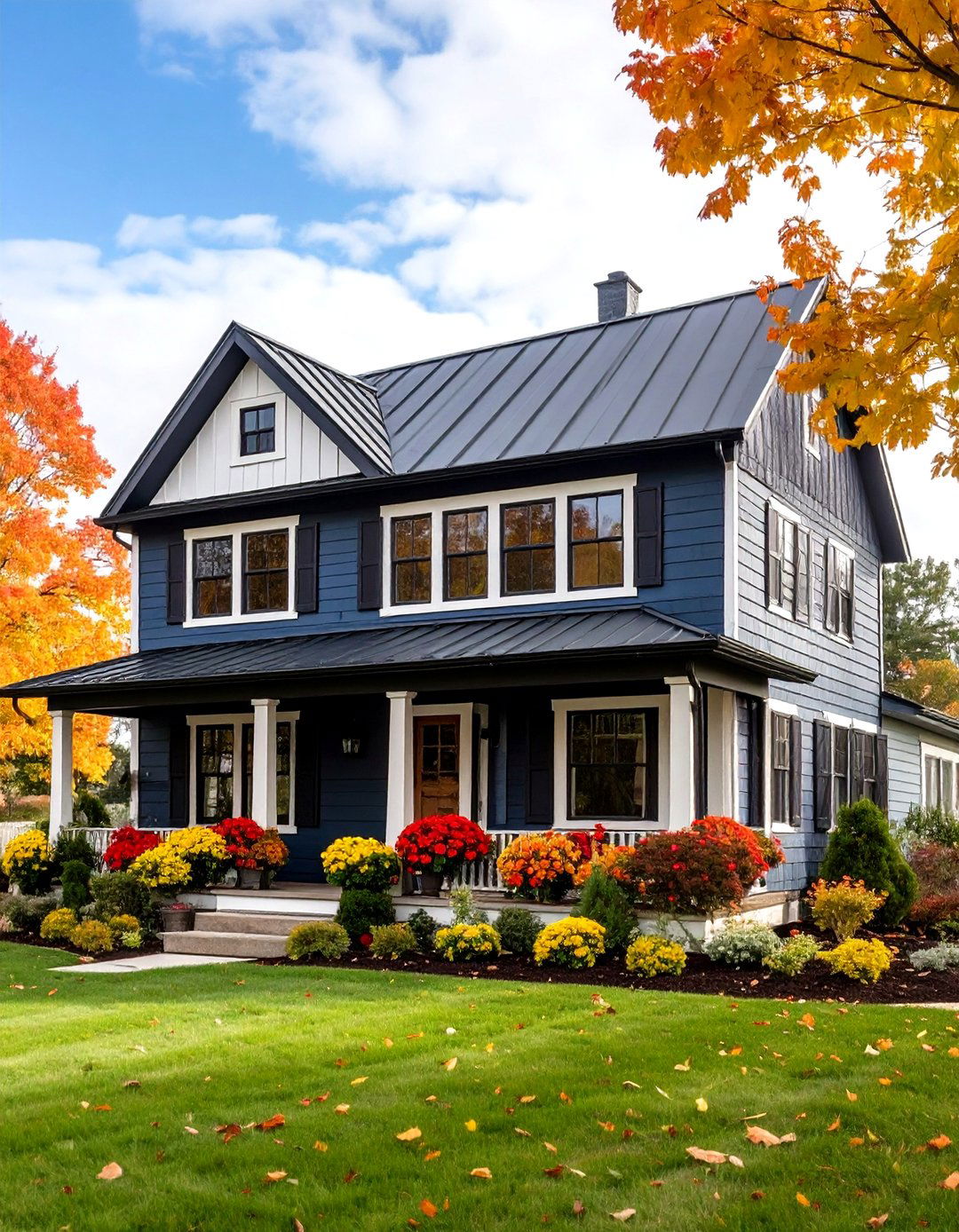

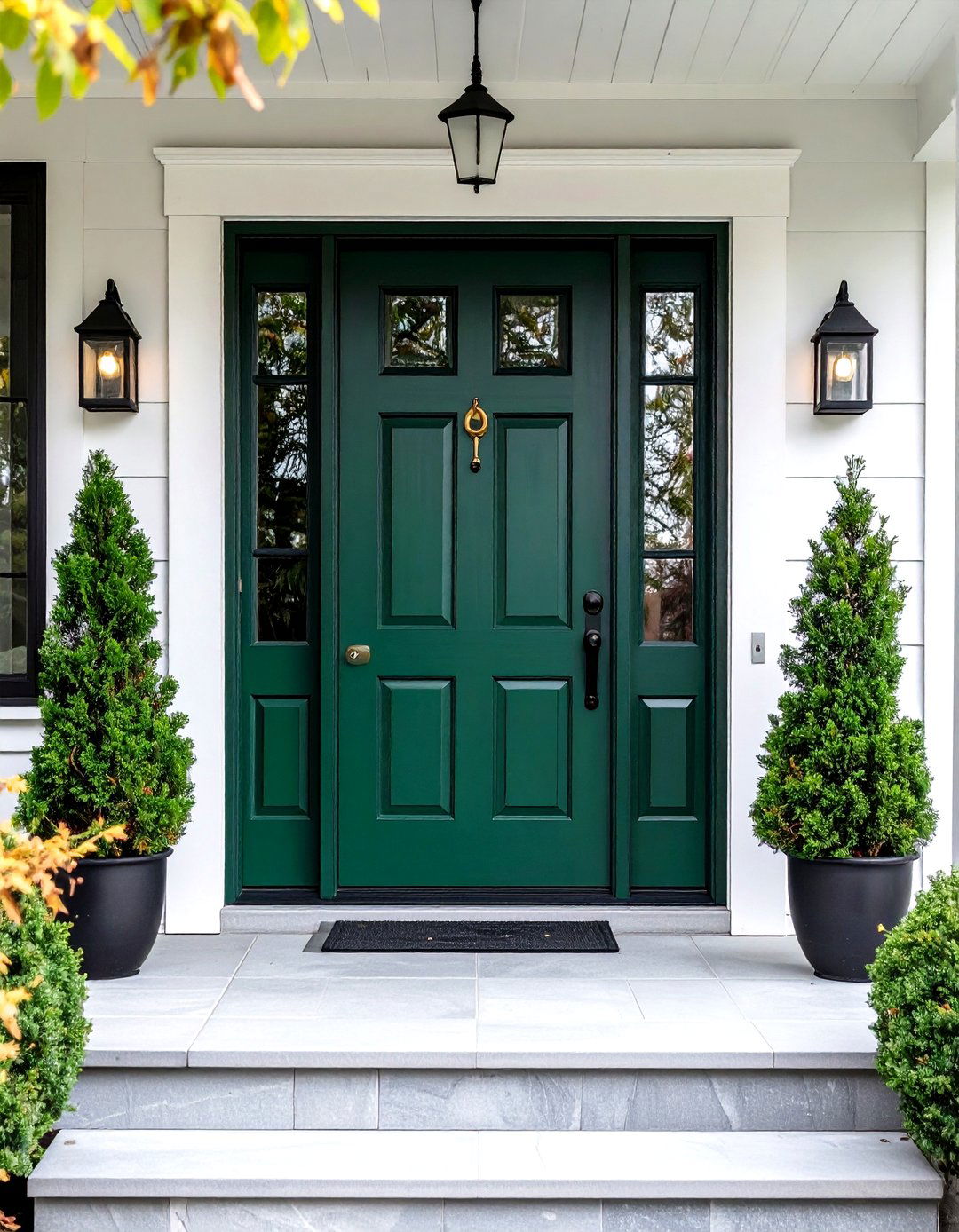
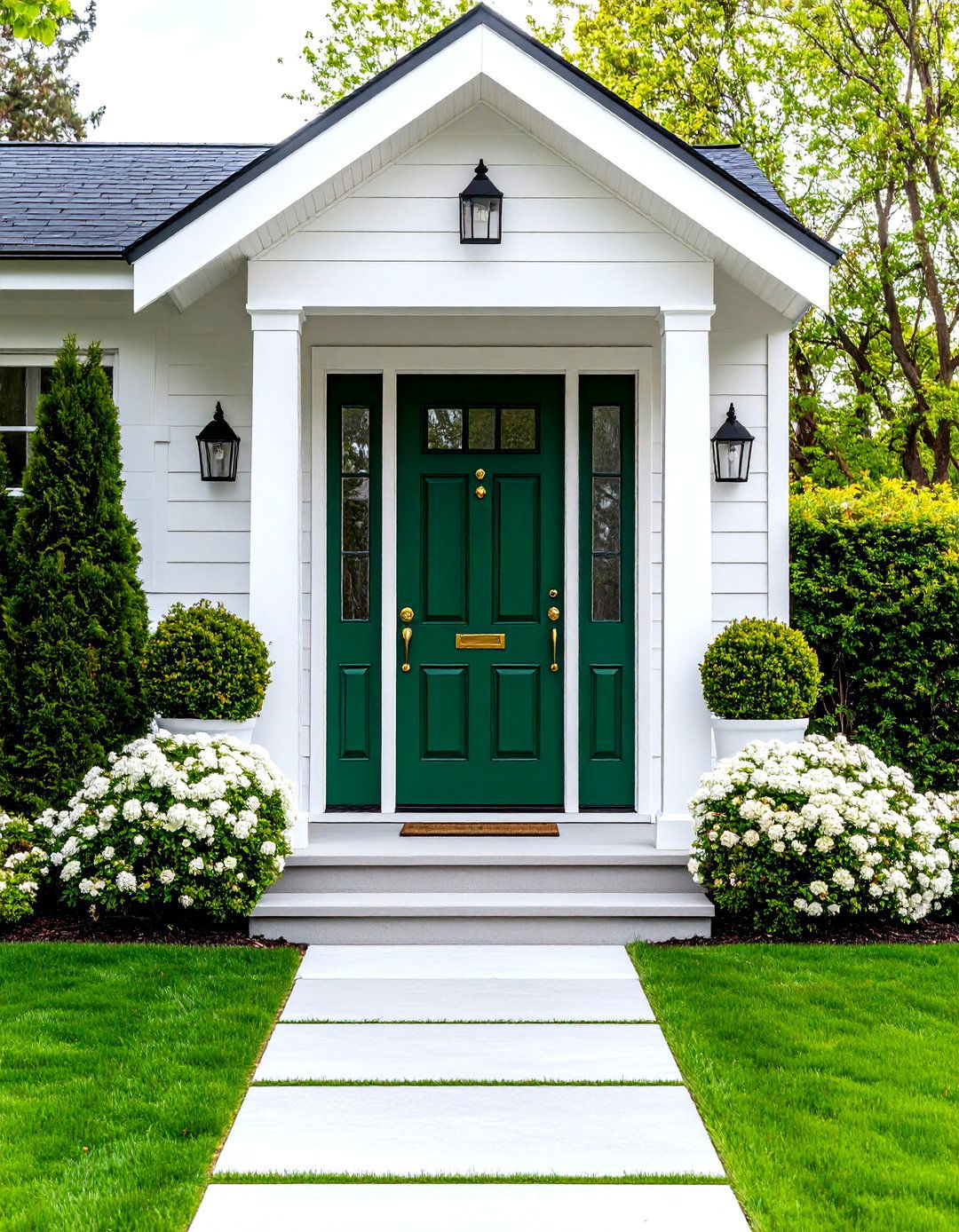
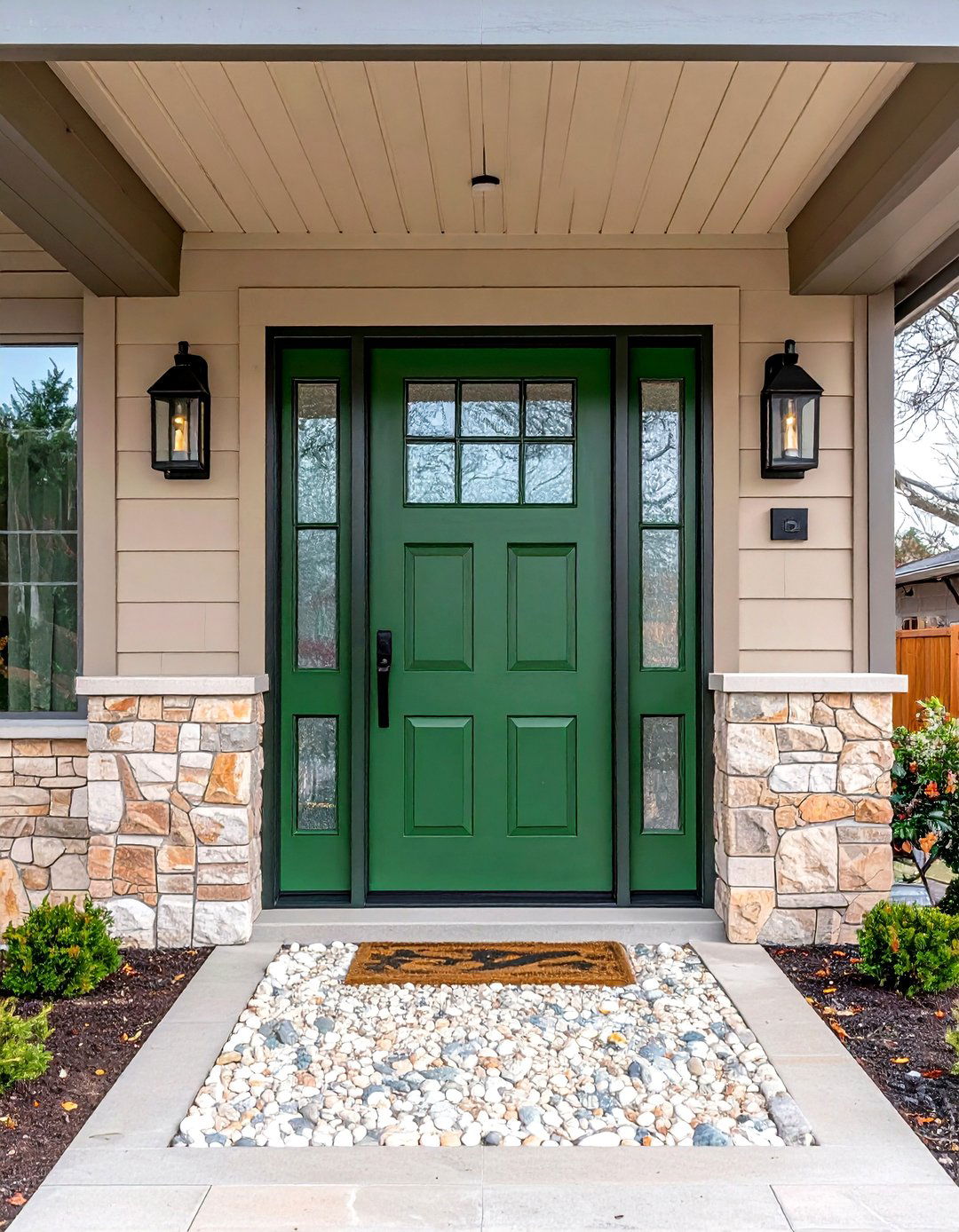
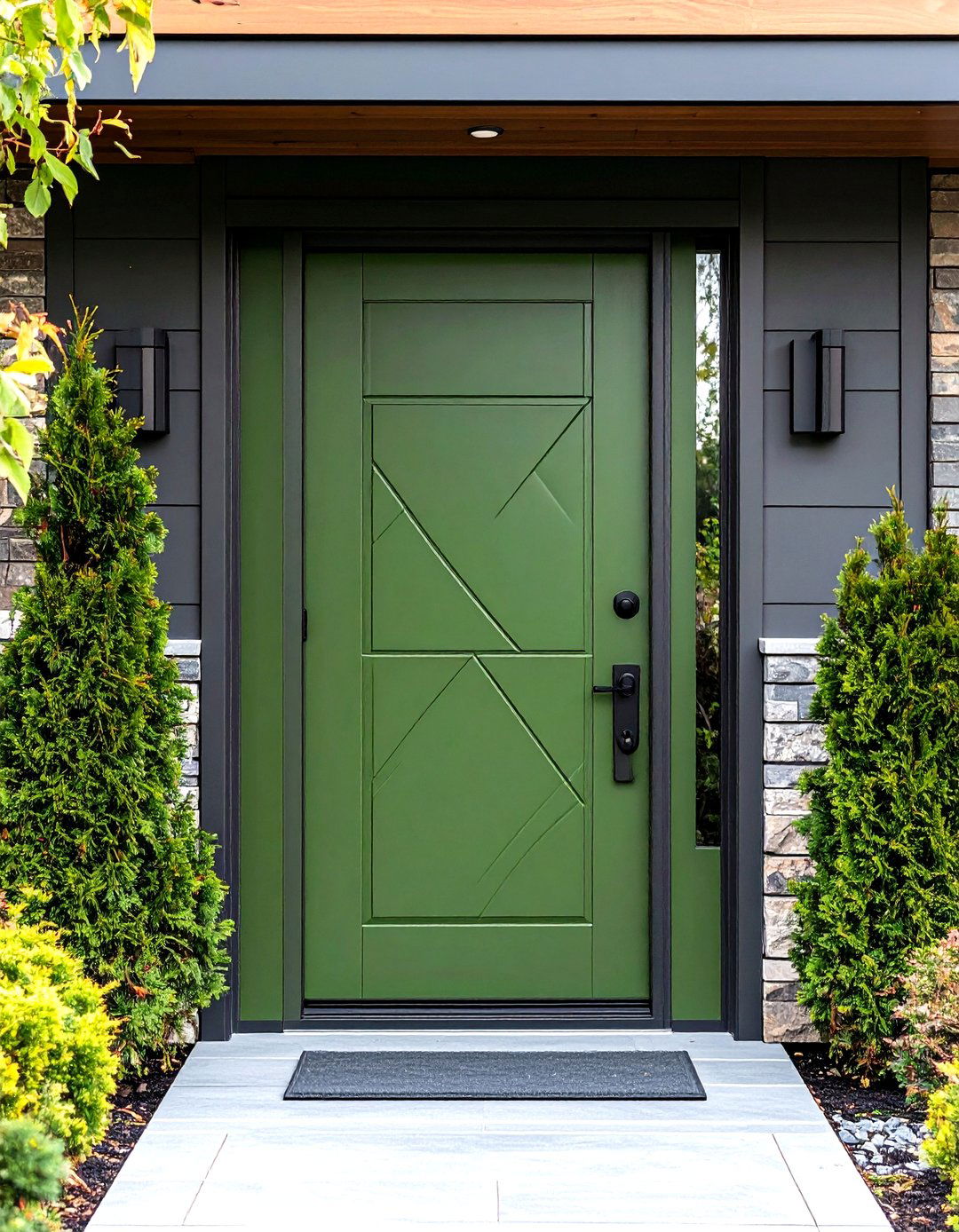

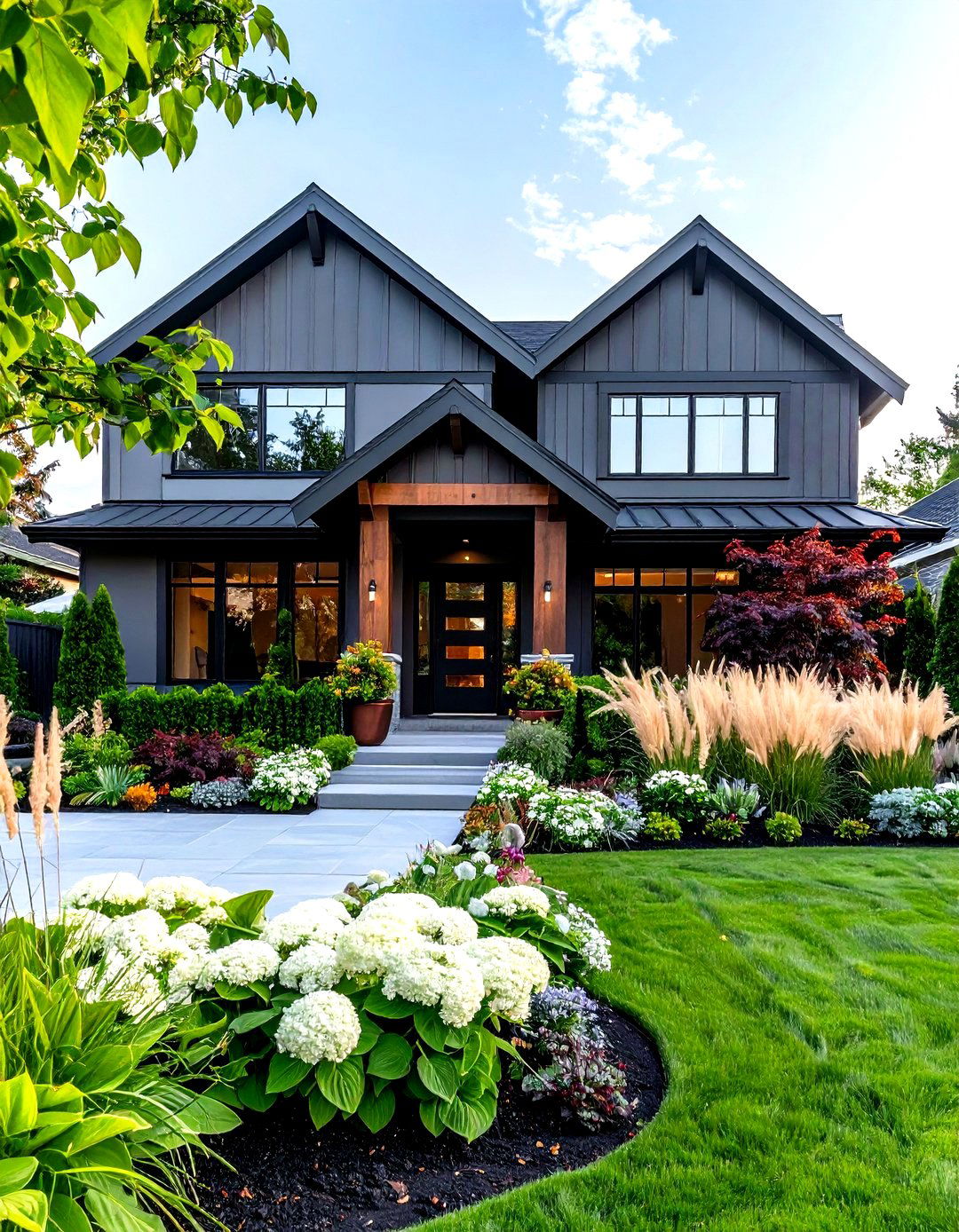

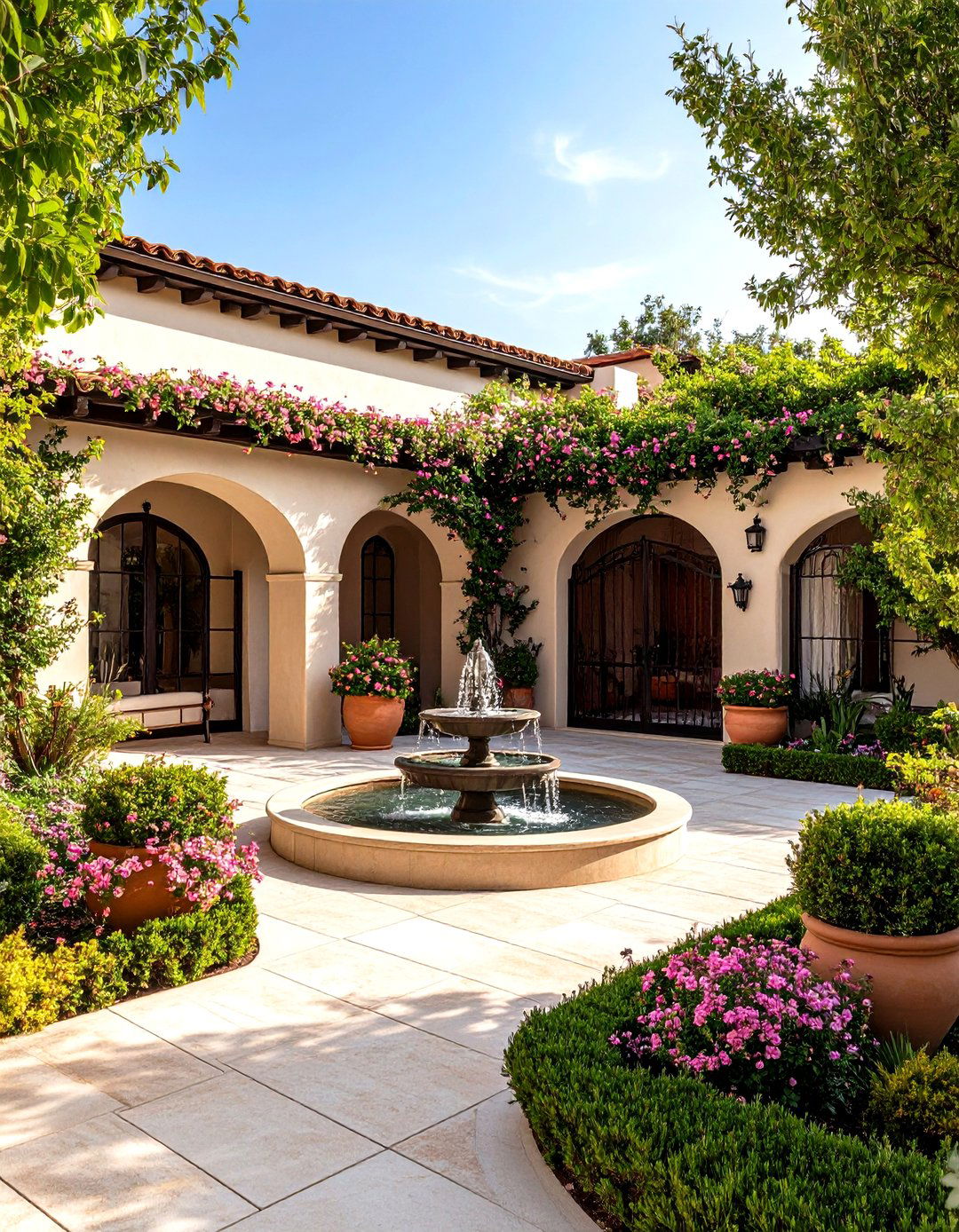


Leave a Reply